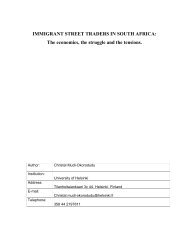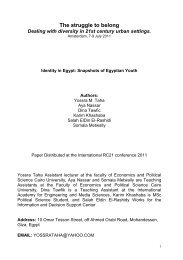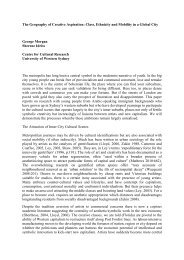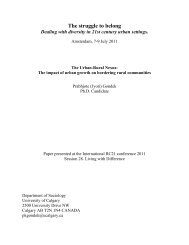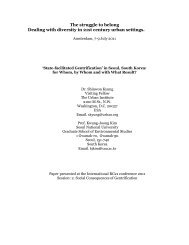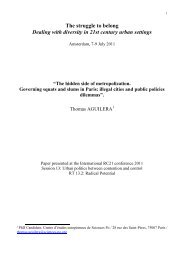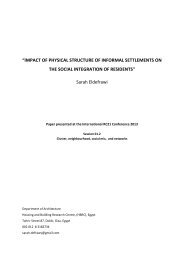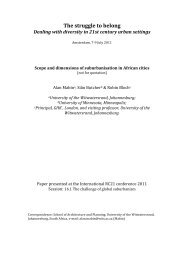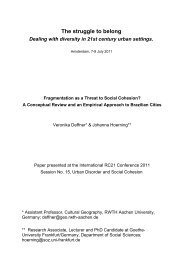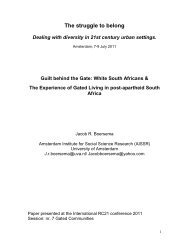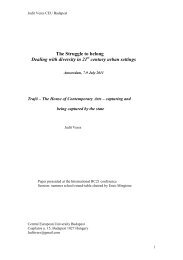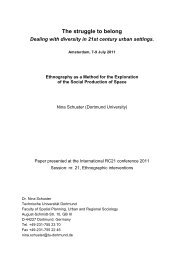Gentrification in the mill land areas of Mumbai city - RC21 ORG ...
Gentrification in the mill land areas of Mumbai city - RC21 ORG ...
Gentrification in the mill land areas of Mumbai city - RC21 ORG ...
You also want an ePaper? Increase the reach of your titles
YUMPU automatically turns print PDFs into web optimized ePapers that Google loves.
Resourceful Cities<br />
Berl<strong>in</strong> (Germany), 29-31 August 2013<br />
<strong>Gentrification</strong> <strong>in</strong> <strong>the</strong> <strong>mill</strong> <strong>land</strong> <strong>areas</strong> <strong>of</strong> <strong>Mumbai</strong> City: A case study<br />
Dwiparna Chatterjee<br />
Paper presented at <strong>the</strong> International RC 21 Conference 2013<br />
Session: 13. Liv<strong>in</strong>g with gentrification.<br />
Department <strong>of</strong> Humanities and Social Science<br />
Indian Institute <strong>of</strong> Technology Bombay<br />
Powai, <strong>Mumbai</strong><br />
dwiparna@iitb.ac.<strong>in</strong>
© <strong>the</strong> author(s)<br />
Not to be quoted without permission
<strong>Gentrification</strong> <strong>in</strong> <strong>the</strong> <strong>mill</strong> <strong>land</strong> <strong>areas</strong> <strong>of</strong> <strong>Mumbai</strong> City: A case study<br />
Abstract<br />
The process <strong>of</strong> gentrification started after <strong>the</strong> closure <strong>of</strong> <strong>the</strong> textile <strong>mill</strong>s <strong>in</strong> <strong>Mumbai</strong>. This<br />
paper tries to br<strong>in</strong>g out <strong>the</strong> process <strong>of</strong> gentrification that is go<strong>in</strong>g on <strong>in</strong> <strong>Mumbai</strong> with <strong>the</strong> help<br />
<strong>of</strong> a case study. The study aims to br<strong>in</strong>g out <strong>the</strong> uniqueness <strong>in</strong> <strong>the</strong> process occurr<strong>in</strong>g here and<br />
its difference from <strong>the</strong> West. It highlights <strong>the</strong> <strong>in</strong>ternal conflict, contestation and <strong>the</strong> daily<br />
negotiation with everyday life that are occurr<strong>in</strong>g <strong>in</strong> <strong>the</strong> neighbourhood. The study looks <strong>in</strong>to<br />
<strong>the</strong> formation <strong>of</strong> gated communities with<strong>in</strong> <strong>the</strong> neighbourhood and <strong>the</strong> sense <strong>of</strong> resentment<br />
and anger among <strong>the</strong> orig<strong>in</strong>al <strong>in</strong>habitants <strong>of</strong> <strong>the</strong> chawls (houses <strong>of</strong> <strong>the</strong> workers) due to <strong>the</strong><br />
<strong>in</strong>evitability <strong>of</strong> <strong>the</strong>ir eviction. The stagnation <strong>of</strong> rent <strong>in</strong> <strong>the</strong> chawls with Rent control act and<br />
its dilapidated condition, <strong>the</strong> astronomical growth <strong>of</strong> <strong>land</strong> values <strong>in</strong> <strong>the</strong> neighbourhood after<br />
<strong>the</strong> closure <strong>of</strong> <strong>the</strong> <strong>mill</strong>s, allowed <strong>the</strong> builders to take over <strong>the</strong> area for redevelopment. The<br />
mov<strong>in</strong>g <strong>in</strong> <strong>of</strong> <strong>the</strong> upper class outsiders and pay<strong>in</strong>g exorbitant rent create certa<strong>in</strong> expectations.<br />
This <strong>in</strong>hibits <strong>the</strong> barga<strong>in</strong><strong>in</strong>g capa<strong>city</strong> among <strong>the</strong> <strong>in</strong>habitants <strong>of</strong> <strong>the</strong> chawl and builders. The<br />
study tries to disentangle <strong>the</strong> complex nexus and tensions between <strong>the</strong> builders, politicians,<br />
upper class residents and chawl owners.<br />
Introduction<br />
The transformation <strong>of</strong> <strong>the</strong> <strong>city</strong> space per se is an important phenomenon <strong>in</strong> today’s world. In<br />
spite <strong>of</strong> its orig<strong>in</strong> <strong>in</strong> west, we witness <strong>city</strong> space’s shape <strong>of</strong> transformation and its gallop<strong>in</strong>g<br />
presence all over <strong>the</strong> world. The processes <strong>of</strong> rejuvenation <strong>of</strong> an underdeveloped <strong>city</strong> area not<br />
only br<strong>in</strong>g structural and functional changes but it also reshuffles <strong>the</strong> socio cultural structure<br />
<strong>of</strong> those <strong>areas</strong>. The <strong>city</strong> not only gets a makeover but it gradually turns <strong>in</strong>to a <strong>land</strong> <strong>of</strong> conflict<br />
and contestation head<strong>in</strong>g towards spatial <strong>in</strong>equality. The outcome <strong>of</strong> <strong>the</strong> <strong>city</strong> redevelopment<br />
is termed differently by different scholars by add<strong>in</strong>g some positive and negative connotations.<br />
<strong>Gentrification</strong> is one such term co<strong>in</strong>ed by urban sociologist Ruth Glass <strong>in</strong> 1964.The process is<br />
not only limited to big cities but it has gradually trickled down to <strong>the</strong> suburbs and rural <strong>areas</strong>,<br />
<strong>the</strong>reby mak<strong>in</strong>g physical alterations <strong>in</strong> <strong>the</strong> built up area, ris<strong>in</strong>g <strong>the</strong> property value and f<strong>in</strong>ally<br />
driv<strong>in</strong>g out <strong>the</strong> poor (Schaffer &Smith, 1986). Much <strong>of</strong> <strong>the</strong> studies <strong>in</strong> gentrification are based<br />
on western context where study <strong>of</strong> gentrification <strong>in</strong> <strong>the</strong> third world country like India<br />
rema<strong>in</strong>ed untouched. Thus <strong>the</strong> study <strong>of</strong> <strong>Mumbai</strong> as a site <strong>of</strong> gentrification become necessary<br />
and worth explor<strong>in</strong>g.
The gentrification process <strong>in</strong> <strong>Mumbai</strong> has acquired prom<strong>in</strong>ent status only after <strong>the</strong> decl<strong>in</strong>e <strong>of</strong><br />
textile <strong>mill</strong>s which was thought to be its lifel<strong>in</strong>e. The huge area <strong>of</strong> Parel, Lower Parel,<br />
Ch<strong>in</strong>chpokli, Sewri, Dadar, and Elph<strong>in</strong>ston known as Girangoan or <strong>the</strong> <strong>land</strong> <strong>of</strong> <strong>the</strong> <strong>mill</strong>s<br />
possessed a historical significance from time immemorial with its <strong>mill</strong> and <strong>in</strong>digenous<br />
culture. It was considered to be <strong>the</strong> birth place <strong>of</strong> <strong>the</strong> work<strong>in</strong>g class and its culture <strong>in</strong> <strong>the</strong> <strong>city</strong>.<br />
The huge <strong>mill</strong> <strong>land</strong>s with magnificent <strong>mill</strong> structure, tall chimneys, <strong>the</strong> sounds <strong>of</strong> <strong>the</strong><br />
mach<strong>in</strong>es, sirens dur<strong>in</strong>g change <strong>of</strong> shifts, <strong>the</strong> chawls <strong>of</strong> workers, forms a milieu <strong>of</strong> <strong>the</strong> <strong>mill</strong>.<br />
However, with <strong>the</strong> advent <strong>of</strong> neoliberal policies <strong>the</strong> process <strong>of</strong> de<strong>in</strong>dustrialisation has<br />
contributed to <strong>the</strong> closure <strong>of</strong> <strong>the</strong> <strong>mill</strong>s one after <strong>the</strong> o<strong>the</strong>r, with <strong>the</strong> longest textile <strong>mill</strong> strike<br />
dur<strong>in</strong>g 80s that lasted for two years (Krishnan, 2000; D’Monte, 2002). Once, honoured as <strong>the</strong><br />
heritage <strong>of</strong> Bombay, textile <strong>mill</strong>s have fallen <strong>in</strong>to a matter <strong>of</strong> disgrace. Gradually, <strong>the</strong> huge<br />
abandoned <strong>land</strong>mass <strong>in</strong> <strong>the</strong> central part <strong>of</strong> <strong>the</strong> <strong>city</strong> became a focal po<strong>in</strong>t <strong>of</strong> attraction for <strong>the</strong><br />
builders and <strong>the</strong> <strong>city</strong> built up area started gentrify<strong>in</strong>g from <strong>the</strong> <strong>land</strong> <strong>of</strong> <strong>mill</strong>s to malls and<br />
towers. New age <strong>of</strong> modern constructions began to occupy <strong>the</strong> old <strong>land</strong> <strong>of</strong> <strong>mill</strong> and with<strong>in</strong> a<br />
span <strong>of</strong> few years what we witness is wholesale deconstruction <strong>of</strong> <strong>the</strong> structure or piecemeal<br />
renovation, that resulted <strong>the</strong> <strong>in</strong>dustrial <strong>land</strong> to get transformed <strong>in</strong>to <strong>the</strong> <strong>land</strong> <strong>of</strong> service sectors<br />
by br<strong>in</strong>g<strong>in</strong>g up new glass façade <strong>of</strong>fices, high end service sectors, enterta<strong>in</strong>ment and new<br />
generation creative <strong>in</strong>dustries. The cont<strong>in</strong>uous speculation <strong>of</strong> <strong>land</strong> value and its astronomical<br />
growth on one hand, with <strong>the</strong> Rent control act application on <strong>the</strong> older chawls <strong>in</strong> <strong>the</strong> locality,<br />
restrict<strong>in</strong>g it to a m<strong>in</strong>imum rent br<strong>in</strong>g<strong>in</strong>g <strong>in</strong> a locational advantage to <strong>the</strong> orig<strong>in</strong>al <strong>in</strong>habitants a<br />
greater barga<strong>in</strong><strong>in</strong>g power. Similarly, <strong>the</strong> newly rich migrant population from all over <strong>the</strong><br />
world found it easy to settle at <strong>the</strong> central location, consequently transform<strong>in</strong>g <strong>mill</strong> <strong>land</strong>s <strong>in</strong>to<br />
<strong>the</strong> <strong>land</strong> <strong>of</strong> transnational elites or ‘transnational capitalist classes’ (R<strong>of</strong>e, 2003) as cited by<br />
Harris (2008:2409). Frequent formation <strong>of</strong> gated communities is produc<strong>in</strong>g an <strong>in</strong>visible wall<br />
mak<strong>in</strong>g <strong>the</strong> locality a <strong>land</strong> <strong>of</strong> contrast. The huge residential towers are juxtaposed to <strong>the</strong> age<br />
old dilapidated chawls <strong>in</strong> <strong>the</strong> vic<strong>in</strong>ity that made <strong>the</strong> built up area <strong>in</strong>to a <strong>land</strong> <strong>of</strong> contestation<br />
where struggles and negotiations become a way <strong>of</strong> life. Therefore, as <strong>the</strong> <strong>city</strong> built up area<br />
transforms it leads to <strong>the</strong> transformation <strong>of</strong> socio-cultural political system and structure with<br />
reconfiguration <strong>of</strong> <strong>the</strong> social space.<br />
Objectives <strong>of</strong> <strong>the</strong> paper<br />
This paper is an attempt to br<strong>in</strong>g out <strong>the</strong> <strong>in</strong>ternal conflict and contestations and <strong>the</strong> daily<br />
negotiation with everyday life that occur <strong>in</strong> <strong>the</strong> neighbourhood <strong>of</strong> Sitaram Yadav Marg when<br />
gentrification has touched <strong>the</strong> area. The paper also looks <strong>in</strong>to <strong>the</strong> process <strong>of</strong> formation <strong>of</strong> <strong>the</strong>
gated community <strong>in</strong> and around <strong>the</strong> neighbourhood, formation <strong>of</strong> <strong>the</strong> imag<strong>in</strong>ary walls that<br />
separates <strong>the</strong> self from <strong>the</strong> o<strong>the</strong>rs, where community liv<strong>in</strong>g is <strong>the</strong> ma<strong>in</strong> mantra. The study<br />
also aims to highlight certa<strong>in</strong> uniqueness <strong>in</strong> <strong>the</strong> process <strong>of</strong> gentrification occurr<strong>in</strong>g <strong>in</strong> <strong>the</strong> <strong>city</strong><br />
<strong>of</strong> <strong>Mumbai</strong> as compared to its experience <strong>in</strong> Western cities, where <strong>the</strong> phenomenon has been<br />
<strong>of</strong>ten understood through <strong>the</strong> conceptual tool <strong>of</strong> revanchism. While <strong>the</strong>re is a sense <strong>of</strong> despair<br />
and anger among <strong>the</strong> orig<strong>in</strong>al work<strong>in</strong>g class residents <strong>of</strong> <strong>the</strong> chawls due to <strong>the</strong> <strong>in</strong>evitability <strong>of</strong><br />
<strong>the</strong>ir eviction from <strong>the</strong>se localities; as outmigration would rob <strong>the</strong>m <strong>of</strong> <strong>the</strong>ir community life<br />
and easy access to work, shopp<strong>in</strong>g, medical and o<strong>the</strong>r facilities. By liv<strong>in</strong>g here, <strong>the</strong>y enjoy<br />
certa<strong>in</strong> situational advantages which give <strong>the</strong>m certa<strong>in</strong> barga<strong>in</strong><strong>in</strong>g capa<strong>city</strong> with <strong>the</strong> builders.<br />
Given <strong>the</strong> astronomical <strong>land</strong> values <strong>in</strong> <strong>the</strong>se neighbourhoods, <strong>the</strong> upper class outsiders<br />
mov<strong>in</strong>g <strong>in</strong> need to pay exorbitant rents or pay huge amounts to buy flats. They <strong>the</strong>refore have<br />
certa<strong>in</strong> expectations and <strong>the</strong> chawls are an eyesore. In comparison <strong>the</strong> orig<strong>in</strong>al <strong>in</strong>habitants pay<br />
ei<strong>the</strong>r notional nom<strong>in</strong>al rent or no rent, given <strong>the</strong> exist<strong>in</strong>g rules <strong>of</strong> <strong>the</strong> Rent Control Act.<br />
Fur<strong>the</strong>rmore by claim<strong>in</strong>g ownership to <strong>the</strong>ir one room tenements, <strong>the</strong> residents <strong>of</strong> <strong>the</strong>se<br />
chawls are able to barga<strong>in</strong> high rates <strong>of</strong> compensation from builders so as to facilitate <strong>the</strong>ir<br />
movement <strong>in</strong>to more comfortable hous<strong>in</strong>g <strong>in</strong> <strong>the</strong> suburbs. The study tries to disentangle <strong>the</strong><br />
complex nexus and tensions between <strong>the</strong> builders, politicians, upper class residents and chawl<br />
owners.<br />
The paper beg<strong>in</strong>s with a brief <strong>in</strong>troduction <strong>of</strong> <strong>city</strong> space transformation followed by<br />
objectives <strong>of</strong> <strong>the</strong> paper. Then it moves gradually towards <strong>the</strong> study <strong>of</strong> neighbourhood: <strong>the</strong><br />
case study, conceptualis<strong>in</strong>g gentrification <strong>in</strong> <strong>the</strong> context <strong>of</strong> <strong>Mumbai</strong> and fur<strong>the</strong>r move towards<br />
chawls <strong>in</strong> neighbourhood and gentrification and redevelopment <strong>of</strong> chawls. The paper explores<br />
<strong>the</strong> transformation and its impact on everyday life and f<strong>in</strong>ally unpacks <strong>the</strong> spatial<br />
transformation and formal <strong>in</strong>formal practices <strong>in</strong> <strong>the</strong> commercial area <strong>of</strong> <strong>the</strong> neighbourhood.<br />
The paper f<strong>in</strong>ally ends with a conclusion.<br />
The Study <strong>of</strong> Neighbourhood: The Case Study<br />
The small neighbourhood along <strong>the</strong> Sitaram Yadav Marg located <strong>in</strong> <strong>the</strong> G/S ward <strong>of</strong> <strong>Mumbai</strong><br />
bears <strong>the</strong> historical imag<strong>in</strong>ation <strong>of</strong> <strong>the</strong> past. There was an agglomeration <strong>of</strong> large and small<br />
<strong>mill</strong>s <strong>in</strong> <strong>the</strong> area from <strong>the</strong> time <strong>of</strong> <strong>in</strong>dustrialisation. Large cotton textile <strong>mill</strong>s <strong>in</strong> this area are<br />
Apollo Mills, Bharat Mills, Jupiter Mills, Madhusudan Mills, <strong>Mumbai</strong> Mills, Podar<br />
Processors (Edward), Podar Mills, Sitaram Mills, Bombay Dye<strong>in</strong>g Mfg Co. Ltd(Lower Parel<br />
– Worli Unit), Century Spg & Wvg Mills, Dawn Mills, Gokuldas Morarji Mills No. 2,
H<strong>in</strong>dustan Spg & Wvg Mills 3 & Process House, Mafatlal Mills Unit Nos. 3, Matulya Mills,<br />
Phoenix <strong>mill</strong>, Piramal Spg & Wvg Mills, Raghuvanshi Mills, Shreeram Mills, Sr<strong>in</strong>ivas Mills,<br />
Standard Mills No.1 (Prabhadevi) and Victoria Mills. Among <strong>the</strong>se <strong>mill</strong>s <strong>the</strong> first eight <strong>mill</strong>s<br />
were under <strong>the</strong> ownership <strong>of</strong> National Textile Corporation and <strong>the</strong> rest were under Mill<br />
Owners Association (Status as <strong>of</strong> September 2006) (Compiled by Ghag, 2006:74-75). O<strong>the</strong>r<br />
than <strong>the</strong>se <strong>mill</strong>s <strong>the</strong>re were some o<strong>the</strong>r textile <strong>mill</strong>s also like Mathuradas Mill, Sun Mill and<br />
Dhanraj Mill which were supposed to be much older than <strong>the</strong> above <strong>mill</strong>s. On <strong>the</strong> western<br />
side <strong>of</strong> <strong>the</strong> Tulsi Pipe L<strong>in</strong>e presently known as Senapati Bapat Marg, few w<strong>in</strong>d<strong>in</strong>g lanes<br />
merge to Sitaram Yadav Marg. The neighbourhood along <strong>the</strong> Sitaram Yadav Marg with old<br />
dilapidated half wooden cl<strong>in</strong>gy chawls with small shops on <strong>the</strong> ground floor on both <strong>the</strong> sides<br />
<strong>of</strong> <strong>the</strong> road with criss cross<strong>in</strong>g by lanes portray <strong>the</strong> story <strong>of</strong> <strong>the</strong> bygone days. The darkness <strong>of</strong><br />
<strong>the</strong> 10/12 square feet room and hundred years old structure at Sitaram Yadav Marg narrates<br />
<strong>the</strong> history <strong>of</strong> <strong>the</strong> textile <strong>mill</strong> workers who are <strong>the</strong> orig<strong>in</strong>al <strong>in</strong>habitants <strong>of</strong> this area. From <strong>the</strong><br />
early morn<strong>in</strong>g till late even<strong>in</strong>g <strong>the</strong> busy and <strong>the</strong> fa<strong>in</strong>eant pedestrians br<strong>in</strong>g life to this place.<br />
The <strong>in</strong>formal daily market at one end <strong>of</strong> <strong>the</strong> road merges to <strong>the</strong> Lower Parel Station and N.M<br />
Joshi Marg. The o<strong>the</strong>r end meets <strong>the</strong> Senapati Bapat Marg.
MAP SHOWING THE DETAIL OF THE STUDY AREA<br />
SOURCE: MCGM<br />
LEGENDS<br />
RG- Proposed Recreation Ground<br />
MAP - Proposed Municipal Primary School<br />
HD- Proposed Hous<strong>in</strong>g for Displaced<br />
PG - Proposed Playground.<br />
SAS- Proposed Municipal Secondary School.<br />
Retention Activity<br />
Blue L<strong>in</strong>e <strong>in</strong>dicates shop l<strong>in</strong>e.<br />
Hatched area is proposed <strong>land</strong> use
Conceptualis<strong>in</strong>g gentrification <strong>in</strong> <strong>the</strong> context <strong>of</strong> <strong>Mumbai</strong><br />
<strong>Gentrification</strong> is a burgeon<strong>in</strong>g phenomenon <strong>in</strong> today’s world, where <strong>the</strong> mean<strong>in</strong>g itself got<br />
gentrified time and aga<strong>in</strong> with certa<strong>in</strong> positive and negative connotation attached to it. In<br />
1980 Oxford American Dictionary states gentrification “as <strong>the</strong> movement <strong>of</strong> middle class<br />
families <strong>in</strong>to urban <strong>areas</strong> caus<strong>in</strong>g property values to rise and hav<strong>in</strong>g <strong>the</strong> secondary effect <strong>of</strong><br />
driv<strong>in</strong>g out poorer families (Schaffer &Smith, 1986:347).” From <strong>the</strong>n onwards different<br />
debates started regard<strong>in</strong>g <strong>the</strong> causes and consequences <strong>of</strong> gentrification, how it had taken<br />
place <strong>in</strong> different cities around <strong>the</strong> world. The term can be expla<strong>in</strong>ed <strong>in</strong> various ways.<br />
Available literature expla<strong>in</strong>s gentrification <strong>in</strong> three different ways. The first was mentioned<br />
by (Ley, 1981, 1996) and o<strong>the</strong>rs who argue that gentrification happens due to <strong>the</strong> shift <strong>in</strong> <strong>the</strong><br />
<strong>in</strong>dustrial structure <strong>in</strong> <strong>the</strong> cities from manufactur<strong>in</strong>g to service based <strong>in</strong>dustries, <strong>the</strong>re by<br />
chang<strong>in</strong>g <strong>the</strong> occupational class structure. Secondly as a result <strong>of</strong> changes <strong>in</strong> class<br />
composition and occupational structure <strong>the</strong>re is also cultural transformation. The middle class<br />
colonises <strong>in</strong> <strong>the</strong> core area <strong>in</strong>stead <strong>of</strong> <strong>the</strong> suburban area. Therefore it is <strong>the</strong> newly formed<br />
middle class which makes gentrification. Thirdly, Smith (1979, 1987, 1996) as cited by<br />
Hamnett (2003) argued that <strong>the</strong> ma<strong>in</strong> force beh<strong>in</strong>d gentrification is not <strong>the</strong> new middle class<br />
but <strong>the</strong> rent gaps. There are three <strong>in</strong>ter related processes that leads to gentrification. First, due<br />
to certa<strong>in</strong> global forces it has been observed as “cascad<strong>in</strong>g <strong>in</strong>to new territories”, secondly, it<br />
is a product <strong>of</strong> cosmopolitan lifestyles practised by certa<strong>in</strong> fractions <strong>of</strong> “transnational<br />
capitalist classes” (R<strong>of</strong>e, 2003: 2518) as cited by Harris (2008) and lastly, it is an important<br />
part <strong>of</strong> neoliberalism. (Harris, 2008: 2409). The process <strong>of</strong> gentrification whe<strong>the</strong>r <strong>in</strong> Europe,<br />
<strong>in</strong> USA or <strong>in</strong> Australia was sporadic <strong>in</strong> nature till <strong>the</strong> neo liberalisation period appeared. Later<br />
with <strong>the</strong> passage <strong>of</strong> time, it had acquired a wider extent. Therefore, <strong>the</strong> ma<strong>in</strong> characteristics <strong>of</strong><br />
gentrification exhibited that it is not only evenly distributed across towns and cities but it is<br />
also concentrated <strong>in</strong> small regions and <strong>areas</strong> <strong>of</strong> large cities such as London, New York, Paris,<br />
Sydney, Toronto, Boston and San Francisco (Hamnett, 2003).<br />
The processes <strong>of</strong> gentrification have both positive and negative impacts. It tends towards<br />
stabilisation <strong>of</strong> <strong>the</strong> decl<strong>in</strong><strong>in</strong>g <strong>areas</strong> by improv<strong>in</strong>g <strong>the</strong> hous<strong>in</strong>g, decentralis<strong>in</strong>g <strong>the</strong> poverty from<br />
<strong>the</strong> area <strong>in</strong>creas<strong>in</strong>g <strong>the</strong> property value and local revenues with fur<strong>the</strong>r development and<br />
ultimately reduc<strong>in</strong>g <strong>the</strong> urban sprawl. It also <strong>in</strong>troduces socio cultural changes <strong>in</strong> <strong>the</strong> area by<br />
<strong>in</strong>creas<strong>in</strong>g social mix<strong>in</strong>g <strong>of</strong> people. At <strong>the</strong> same time <strong>the</strong> process <strong>of</strong> gentrification causes<br />
large scale displacement <strong>of</strong> population <strong>the</strong>reby creat<strong>in</strong>g homelessness. This displacement <strong>of</strong><br />
population is due to <strong>in</strong>crease <strong>of</strong> price and high demand for hous<strong>in</strong>g. Therefore, this process
always receives mixed op<strong>in</strong>ion from <strong>the</strong> policy makers, researchers, urban sociologists and<br />
planners. For some gentrification helps to rega<strong>in</strong> money by revitalisation <strong>of</strong> <strong>areas</strong> whereas for<br />
o<strong>the</strong>rs it is a huge social cost <strong>in</strong>curred <strong>in</strong> an area <strong>in</strong> order to rejuvenate, <strong>the</strong>reby caus<strong>in</strong>g large<br />
displacement <strong>of</strong> population and little or no ga<strong>in</strong> for <strong>the</strong> <strong>city</strong> (Atk<strong>in</strong>son, 2004).<br />
<strong>Gentrification</strong> does not follow any discreet process; it <strong>of</strong>ten acts <strong>in</strong> <strong>the</strong> comb<strong>in</strong>ation with<br />
many. Therefore whe<strong>the</strong>r it is <strong>in</strong> <strong>the</strong> form <strong>of</strong> displacement <strong>of</strong> population from <strong>the</strong> <strong>in</strong>ner <strong>city</strong><br />
due to <strong>the</strong> process <strong>of</strong> de<strong>in</strong>dustrialisation, displacement due to racial conflict <strong>in</strong> places like<br />
Harlem, upcom<strong>in</strong>g cafes, bars nightclubs and art galleries <strong>in</strong> SoHo <strong>of</strong> New York and<br />
formation <strong>of</strong> new cultural capital eras<strong>in</strong>g <strong>the</strong> old or movement <strong>of</strong> people back to <strong>the</strong> <strong>city</strong> from<br />
<strong>the</strong> suburbs popularised as ‘revanchism’ <strong>in</strong> <strong>the</strong> Society Hill Philadelphia or <strong>in</strong> Wash<strong>in</strong>gton<br />
DC(Smith,1996:52) <strong>the</strong> various discourses <strong>of</strong> gentrification occurs <strong>in</strong> various stages.<br />
When we compare <strong>the</strong> develop<strong>in</strong>g world with developed world it is found that <strong>the</strong>re is always<br />
a difference between <strong>the</strong> first world cities and <strong>the</strong> third world cities round <strong>the</strong> world (Deb,<br />
2006). Specifically, <strong>in</strong> India <strong>the</strong> contrast is very prom<strong>in</strong>ent because India once be<strong>in</strong>g a<br />
colonial country had <strong>the</strong> centralised adm<strong>in</strong>istrative system. Therefore <strong>the</strong> role <strong>of</strong> <strong>the</strong> state is<br />
very important here. Moreover a large number <strong>of</strong> population <strong>in</strong> India is under <strong>the</strong> below<br />
poverty l<strong>in</strong>e and <strong>the</strong> technological development is low as compared to o<strong>the</strong>r countries. All<br />
<strong>the</strong>se drawbacks compel government to form different policies for its growth and<br />
development. To study <strong>the</strong> growth and development <strong>of</strong> Indian cities Marxist approach seems<br />
to be relevant as Deb (2006: 347) stated that, “presently cities <strong>in</strong> India are grow<strong>in</strong>g accord<strong>in</strong>g<br />
<strong>the</strong> logic <strong>of</strong> capitalist mode <strong>of</strong> accumulation <strong>of</strong> surplus. The urban <strong>land</strong> use is <strong>the</strong>refore<br />
primarily structured by a rent maximis<strong>in</strong>g <strong>land</strong> market and <strong>the</strong> geographical pattern that<br />
develops is <strong>of</strong> a dense commercial core, a tendency for ever widen<strong>in</strong>g peripheral scatter<strong>in</strong>g <strong>of</strong><br />
<strong>in</strong>dustries and <strong>the</strong> appearance <strong>of</strong> socially segregated residential neighbourhoods”. In <strong>the</strong><br />
Marxist approach <strong>the</strong> accumulation <strong>of</strong> capital takes place <strong>in</strong> <strong>the</strong> production sphere i.e.<br />
<strong>in</strong>dustries, gets circulated <strong>in</strong> <strong>the</strong> circulation sphere by roads, highways, commerce, bank<strong>in</strong>g<br />
etc and goes to <strong>the</strong> reproduction sphere which <strong>in</strong> this case is hous<strong>in</strong>g for <strong>the</strong> labourers near<br />
<strong>the</strong>ir work<strong>in</strong>g place. Due to pr<strong>of</strong>it motive approach <strong>of</strong> <strong>the</strong> capitalist <strong>the</strong>re are many sectors<br />
where <strong>the</strong> private <strong>in</strong>vestors do not f<strong>in</strong>d any <strong>in</strong>terest to <strong>in</strong>terfere. State’s <strong>in</strong>tervention at that<br />
po<strong>in</strong>t <strong>of</strong> time becomes very important. Any breakdown <strong>in</strong> <strong>the</strong> equilibrium among <strong>the</strong> three<br />
spheres can lead to crises. Like any o<strong>the</strong>r cities <strong>of</strong> India, <strong>in</strong> <strong>Mumbai</strong> <strong>the</strong> State <strong>of</strong>ten acts as an<br />
agent <strong>of</strong> <strong>the</strong> capitalist class because it is operat<strong>in</strong>g under <strong>the</strong> capitalist system. At this po<strong>in</strong>t I
would like to take up a case study <strong>of</strong> gentrification happen<strong>in</strong>g <strong>in</strong> <strong>the</strong> neighbourhood <strong>of</strong> <strong>the</strong><br />
<strong>mill</strong> <strong>land</strong>s <strong>in</strong> <strong>Mumbai</strong>.<br />
<strong>Gentrification</strong> <strong>in</strong> <strong>the</strong> textile <strong>mill</strong> <strong>land</strong>s <strong>of</strong> <strong>Mumbai</strong> started after <strong>the</strong> closure <strong>of</strong> <strong>the</strong> textile <strong>mill</strong>s<br />
and with <strong>the</strong> formulation <strong>of</strong> <strong>the</strong> neo liberal policies. The government and <strong>the</strong> <strong>mill</strong> owners<br />
formulated certa<strong>in</strong> policies for redevelopment <strong>in</strong> order to revive <strong>the</strong> <strong>mill</strong>s and to generate<br />
pr<strong>of</strong>it from it. But <strong>the</strong> orig<strong>in</strong>al motive beh<strong>in</strong>d <strong>the</strong> revival was never philanthropic. With<br />
certa<strong>in</strong> vested <strong>in</strong>terest <strong>in</strong> <strong>the</strong>ir m<strong>in</strong>d, <strong>the</strong> portion <strong>of</strong> <strong>the</strong> <strong>mill</strong>s which were not sick was also<br />
made to be sick ei<strong>the</strong>r by sell<strong>in</strong>g <strong>the</strong> mach<strong>in</strong>eries from <strong>the</strong> <strong>mill</strong>s or by excessive retrenchment.<br />
The <strong>mill</strong> owners looked for short term pr<strong>of</strong>it and <strong>the</strong>y siphoned <strong>of</strong>f <strong>the</strong> money to o<strong>the</strong>r<br />
commercial projects <strong>in</strong> order to make more pr<strong>of</strong>it (D’Monte, 2002; Adarkar, 2006)<br />
The <strong>mill</strong>s started clos<strong>in</strong>g one after <strong>the</strong> o<strong>the</strong>r after <strong>the</strong> great textile <strong>mill</strong> strike. The <strong>mill</strong> <strong>land</strong>s<br />
and associated chawls <strong>in</strong> <strong>the</strong> neighbourhood went <strong>in</strong>to a blighted condition. This phase was<br />
aggravated by change <strong>in</strong> occupational structure that caused to outmigration <strong>of</strong> people. As<br />
<strong>mill</strong>s went on clos<strong>in</strong>g, <strong>the</strong>re was a large scale retrenchment <strong>of</strong> <strong>the</strong> workers with m<strong>in</strong>imum<br />
compensation. Workers were forced to take retirement with meagre compensation. Those who<br />
have taken <strong>the</strong> retirement <strong>in</strong>1993 under <strong>the</strong> pressure <strong>of</strong> <strong>the</strong> <strong>mill</strong> owners and <strong>the</strong> active trade<br />
union RMMS received a compensation <strong>of</strong> merely Rs 60,000 to 70,000. But those who have<br />
managed to work <strong>in</strong> <strong>the</strong> <strong>mill</strong> till 1996 <strong>the</strong>y have received a compensation <strong>of</strong> approx 1 lakh 70<br />
thousand rupees or more accord<strong>in</strong>g to <strong>the</strong> year <strong>of</strong> service. But those who were badli workers<br />
<strong>the</strong>y did not received anyth<strong>in</strong>g.<br />
When we glance through <strong>the</strong> migration pattern <strong>of</strong> <strong>the</strong> area, we realize that, dur<strong>in</strong>g this period<br />
many have returned back to <strong>the</strong>ir villages. Out <strong>of</strong> <strong>the</strong>m some returned after a long period <strong>of</strong><br />
time. It has been noted <strong>in</strong> <strong>the</strong> census that <strong>in</strong> <strong>the</strong> G/S ward at Ch<strong>in</strong>chpokli Section <strong>the</strong><br />
population <strong>in</strong>creased till 1981 with a positive decadal growth rate <strong>of</strong> 4.49 percent <strong>in</strong> 1961-71<br />
and 17.05 percent <strong>in</strong> 1971-81whereas s<strong>in</strong>ce <strong>the</strong>n it started decreas<strong>in</strong>g cont<strong>in</strong>uously with a<br />
negative decadal growth rate <strong>of</strong> -5.98percent <strong>in</strong> 1981-91 and -4.02 percent <strong>in</strong> 1991-2001.<br />
Consider<strong>in</strong>g <strong>the</strong> male population, it has <strong>in</strong>creased till 1981 with a positive decadal growth rate<br />
<strong>of</strong> 2.24 percent <strong>in</strong> 1961-71 and 14.99 percent <strong>in</strong> 1971-81. But as <strong>the</strong> total population<br />
decreased <strong>the</strong> male population simultaneously decreased with a negative decadal growth rate<br />
<strong>of</strong> -10.65percent <strong>in</strong> 1981-91 and -6.18 percent <strong>in</strong> 1991-2001.The female population on <strong>the</strong><br />
o<strong>the</strong>r hand rose steadily till 1991 with a positive decadal growth rate <strong>of</strong> 9.07 percent <strong>in</strong> 1961-<br />
71 and 21.10 percent <strong>in</strong> 1971-1981.In 1981-91 though <strong>the</strong> female population <strong>in</strong>creased but <strong>the</strong>
decadal growth rate decl<strong>in</strong>ed to 2.60 percent. In 2001<strong>the</strong> decadal growth rate became negative<br />
-.568 percent. Related to occupational changes it has been noted that <strong>the</strong> non work<strong>in</strong>g<br />
population <strong>in</strong> 1981 was 56.29 percent. In 1991 it <strong>in</strong>creased to 58.69 percent and <strong>in</strong> 2001 it<br />
became 58.52 percent (District Census Handbook <strong>Mumbai</strong>, 1981-2001). Therefore <strong>the</strong> overall<br />
situation creates a ‘hollow effect’ or ‘donut effect’ (Pendse, Adarkar & F<strong>in</strong>kelste<strong>in</strong>, 2011:6) <strong>in</strong><br />
<strong>the</strong> area and <strong>the</strong> entire <strong>city</strong> space got reshuffled.<br />
Government policies also played fundamental role <strong>in</strong> gentrification. For example, as per <strong>the</strong><br />
<strong>Mumbai</strong> regional plan, a number <strong>of</strong> textile <strong>mill</strong>s shifted to suburban area. But with<strong>in</strong> <strong>the</strong> <strong>city</strong><br />
after <strong>the</strong> closure <strong>of</strong> <strong>the</strong> <strong>mill</strong>s 600 acres <strong>of</strong> <strong>land</strong> had been generated. These <strong>land</strong>s could have<br />
been judiciously used by produc<strong>in</strong>g a large open space for its citizen, but <strong>the</strong> <strong>land</strong> became a<br />
matter <strong>of</strong> higher speculation for <strong>the</strong> <strong>mill</strong> owners, builders and government. In 1991 <strong>the</strong><br />
Development Control Rule 58 was formed. Under this rule <strong>the</strong> <strong>mill</strong> owner could develop <strong>the</strong><br />
<strong>land</strong> ei<strong>the</strong>r by demolish<strong>in</strong>g <strong>the</strong> <strong>mill</strong> structure or by reta<strong>in</strong><strong>in</strong>g <strong>the</strong> <strong>mill</strong> structure. If <strong>the</strong> owner<br />
demolishes <strong>the</strong> <strong>mill</strong> structure he is suppose to hand over 33 percent to B.M.C (Bombay<br />
Municipal Corporation), 27 percent to MHADA (Maharashtra Hous<strong>in</strong>g Area Development<br />
Authority) and 40 percent for <strong>the</strong> <strong>mill</strong> owners <strong>the</strong>mselves (D’Monte, 2002). Therefore a very<br />
small amount is be<strong>in</strong>g left for <strong>the</strong> owners. Development <strong>of</strong> only 40 percent <strong>of</strong> <strong>the</strong> <strong>land</strong><br />
became unsuitable to <strong>the</strong> <strong>mill</strong> owners. So some <strong>of</strong> <strong>the</strong>m started restor<strong>in</strong>g <strong>the</strong> <strong>mill</strong> structure<br />
and started redevelopment <strong>in</strong> a haphazard manner. Sometimes <strong>the</strong>y rented out or leased out<br />
part <strong>of</strong> <strong>the</strong> <strong>land</strong> for different commercial purposes. In a way <strong>the</strong>y could escape from <strong>the</strong><br />
submission <strong>of</strong> <strong>the</strong> <strong>land</strong> to <strong>the</strong> BMC (Bombay Municipal Corporation) and MHADA<br />
(Maharashtra Hous<strong>in</strong>g Area Development Authority). In 2001 <strong>the</strong> modified D.C Rules came<br />
<strong>in</strong>to effect. It allowed <strong>the</strong> <strong>mill</strong> owner to demolish <strong>the</strong> <strong>mill</strong> structure without any submission <strong>of</strong><br />
<strong>land</strong> to <strong>the</strong> BMC, MHADA. The <strong>mill</strong> owners started for a planned development. But for<br />
Chandavarkar (2005), <strong>the</strong> new DC rules totally wiped out <strong>the</strong> public <strong>in</strong>terest and made th<strong>in</strong>gs<br />
absolutely for <strong>the</strong> <strong>in</strong>terest <strong>of</strong> <strong>the</strong> builders. Immediately after <strong>the</strong> modified DC rule <strong>the</strong> owner’s<br />
share at <strong>the</strong> Victoria Mill at Lower Parel <strong>in</strong>creased from 40 percent to 78 percent. The entire<br />
area <strong>of</strong> <strong>the</strong> Kamla <strong>mill</strong> has been transformed <strong>in</strong>to Corporate Offices without leav<strong>in</strong>g anyth<strong>in</strong>g<br />
for open spaces and low cost hous<strong>in</strong>g. The Phoenix Mill has been developed <strong>in</strong>to High Street<br />
Phoenix Mall with two towers and disco<strong>the</strong>que leav<strong>in</strong>g no space for low cost hous<strong>in</strong>g and<br />
open space. For Piramal Mill after <strong>the</strong> new DC rules <strong>the</strong> area for <strong>the</strong> owner <strong>in</strong>creased from<br />
14,200 sq metres to 32,712 sq metres and <strong>the</strong> area <strong>of</strong> recreation ground decreased from<br />
11,715 sq metres to 1,533 sq metres. The area for public hous<strong>in</strong>g also decreased from 9,585
sq metres to 1,255 sq metres (The Times <strong>of</strong> India, 19 Dec 2004).The Jupiter <strong>mill</strong> under<br />
N.T.C. (National Textile Corporation) only shared 9 percent <strong>of</strong> vacant <strong>land</strong> to BMC and<br />
MHADA. (The Times <strong>of</strong> India, March 13, 2005).Casa Grande “two ultra- luxury 23 storey<br />
build<strong>in</strong>gs” has been constructed on Matulya Mill. To Atul Ruia <strong>of</strong> Phoenix Mill, development<br />
is quite different. “Old and derelict <strong>mill</strong> structures are be<strong>in</strong>g replaced by good quality hous<strong>in</strong>g<br />
projects surrounded by gardens, recreation grounds,” as told to Newsl<strong>in</strong>e. “This is planned<br />
development.”(Mehta and Choudhury 2005, Indian Express) In Morarjee Mill Unit 1 <strong>the</strong><br />
luxurious Ashoka Tower came up this is named as <strong>the</strong> Pen<strong>in</strong>sula Tower by demolish<strong>in</strong>g <strong>the</strong><br />
<strong>mill</strong> structure. Morarjee Unit 2 has been transformed <strong>in</strong>to a world class <strong>of</strong>fice on 400 acres <strong>of</strong><br />
<strong>land</strong> which is about <strong>the</strong> size <strong>of</strong> six Nariman po<strong>in</strong>t. Rajeev Piramal <strong>in</strong> an <strong>in</strong>terview stated,<br />
“Mill <strong>land</strong>s cannot be s<strong>in</strong>gled out to solve <strong>Mumbai</strong>’s problems. Why should we give up our<br />
<strong>land</strong>”(Choudhury& Mehta 2005, Indian Express). Dur<strong>in</strong>g <strong>the</strong> period <strong>of</strong> 2005 to 2010, eight<br />
NTC <strong>mill</strong>s sold <strong>the</strong>ir <strong>land</strong> to different real estate builders. Jupiter <strong>mill</strong> sold 11 acres <strong>of</strong> <strong>land</strong> to<br />
India Bulls at 276 crore. Apollo <strong>mill</strong> sold 7.5 acres <strong>of</strong> <strong>land</strong> to Lodha group at Rs 180 crore.<br />
<strong>Mumbai</strong> Textile sold 17 acres <strong>of</strong> <strong>land</strong> to DLF Akruti at Rs 702 crores, 8 acres <strong>of</strong> Elph<strong>in</strong>stone<br />
<strong>mill</strong> <strong>land</strong> is sold to India Bulls at Rs 441 crore, 4.8 acres <strong>of</strong> Koh<strong>in</strong>oor <strong>mill</strong> <strong>land</strong> had been sold<br />
to Koh<strong>in</strong>oor at Rs 421 crore, 2.39 acres <strong>of</strong> Poddar Processes sold to India Bulls at Rs 474<br />
crores, 8.37 acres <strong>of</strong> Bharat Textile <strong>land</strong> is sold to India Bulls at Rs 1505 crores, and 10.4<br />
acres <strong>of</strong> F<strong>in</strong>lay <strong>mill</strong>s sold to Lodha at Rs 657 crore. (Data compiled by Girni Kamgar<br />
Sangharsh Samity)With <strong>the</strong> redevelopment policy <strong>the</strong> <strong>city</strong> <strong>of</strong> <strong>Mumbai</strong> transited itself from<br />
‘multi ethnic multi l<strong>in</strong>gual cosmopolitan culture to bourgeoisie class based modernity (Patel,<br />
2010) which had been fur<strong>the</strong>r asserted by Chatterjee (2003) <strong>in</strong>, “Are Indian Cities Becom<strong>in</strong>g<br />
Bourgeoisie at last” Area surround<strong>in</strong>g <strong>the</strong> <strong>mill</strong> <strong>land</strong>s became expensive due to <strong>the</strong> strong<br />
market force that started operat<strong>in</strong>g <strong>the</strong>re and <strong>the</strong> <strong>mill</strong> workers started mov<strong>in</strong>g out and it<br />
became gold m<strong>in</strong>e for <strong>the</strong> builders.<br />
Chawls <strong>in</strong> <strong>the</strong> Neighbourhood<br />
There are number <strong>of</strong> chawls <strong>in</strong> <strong>the</strong> neighbourhood with a gate at <strong>the</strong> entrance where <strong>the</strong> name<br />
<strong>of</strong> <strong>the</strong> chawl is written with name <strong>of</strong> <strong>the</strong> society and <strong>the</strong> year. At <strong>the</strong> entrance, <strong>the</strong>re is a space<br />
for sitt<strong>in</strong>g on both <strong>the</strong> sides made up <strong>of</strong> cement, where mostly are children found play<strong>in</strong>g.<br />
Usually <strong>the</strong>se portions rema<strong>in</strong> very dark and cool dur<strong>in</strong>g <strong>the</strong> day. Every time one entered <strong>the</strong><br />
chawl dur<strong>in</strong>g <strong>the</strong> day <strong>in</strong> <strong>the</strong> hot summer months, felt a sigh <strong>of</strong> relief. There is also a small<br />
religious space <strong>in</strong> every chawl just beside <strong>the</strong> ma<strong>in</strong> gate. Mostly <strong>the</strong> idol <strong>of</strong> Shirdi Sai Baba<br />
and Hanumanji are kept <strong>in</strong> it. The religious space is always specially secured with grill gate.
Often I have seen people rest<strong>in</strong>g <strong>in</strong> that area dur<strong>in</strong>g <strong>the</strong> day. The chawls which are bigger <strong>in</strong><br />
area with a courtyard <strong>in</strong>side have <strong>the</strong>ir religious space <strong>in</strong> <strong>the</strong> courtyard. Sometimes I found <strong>the</strong><br />
religious space around <strong>the</strong> corner <strong>of</strong> <strong>the</strong> staircase <strong>in</strong> each and every floor. While explor<strong>in</strong>g <strong>the</strong><br />
chawl from one floor to ano<strong>the</strong>r I came across an area specially made for sitt<strong>in</strong>g and rest<strong>in</strong>g.<br />
Each and every floor has a long corridor which usually rema<strong>in</strong>s very dark dur<strong>in</strong>g <strong>the</strong> day with<br />
all <strong>the</strong> rooms hav<strong>in</strong>g <strong>the</strong>ir doors open fac<strong>in</strong>g towards each o<strong>the</strong>r. The dark corridor rema<strong>in</strong>s<br />
filled with colourful clo<strong>the</strong>s hang<strong>in</strong>g from <strong>the</strong> top. The chawls hav<strong>in</strong>g courtyard are generally<br />
rectangular pattern with very long common gallery runn<strong>in</strong>g all through. For all <strong>the</strong> chawls <strong>the</strong><br />
toilets are arranged separately on one corner <strong>of</strong> <strong>the</strong> corridor with a separate wash<strong>in</strong>g area.<br />
Generally four to five toilets are grouped toge<strong>the</strong>r for each floor. In some <strong>of</strong> <strong>the</strong> chawls I<br />
noticed <strong>the</strong> toilets are totally outside. The rooms <strong>in</strong> every chawl are very small sometimes<br />
with or without separate kitchen. The size <strong>of</strong> <strong>the</strong> room generally is 225 sqfeet, 325 sqfeet<br />
sometimes 375 square feet to 450sq feet. Each and every room has a l<strong>of</strong>t with a wooden<br />
staircase and an half enclosed area with maximum three to four feet wall on one side for<br />
bath<strong>in</strong>g, chang<strong>in</strong>g clo<strong>the</strong>s and wash<strong>in</strong>g utensils. This seemed to me <strong>the</strong> only legalised private<br />
space <strong>in</strong> <strong>the</strong> room although <strong>the</strong> l<strong>of</strong>t can also be used as a private corner.<br />
These chawls were occupied by <strong>the</strong> <strong>mill</strong> workers at a very nom<strong>in</strong>al rent or almost without any<br />
rent when <strong>mill</strong>s were functional. Frequent shift<strong>in</strong>g <strong>of</strong> rooms by workers from one chawl to<br />
ano<strong>the</strong>r alludes to <strong>the</strong> enough space available for <strong>the</strong>m dur<strong>in</strong>g <strong>the</strong> early period. But dur<strong>in</strong>g <strong>the</strong><br />
later phase twenty people would stay toge<strong>the</strong>r <strong>in</strong> a s<strong>in</strong>gle room. Some <strong>of</strong> <strong>the</strong> chawls were<br />
directly attached to <strong>the</strong> <strong>mill</strong>s and some were privately built. With <strong>the</strong> passage <strong>of</strong> time, rent<br />
control act brought <strong>in</strong> stagnation <strong>of</strong> rent. Therefore apart from m<strong>in</strong>or alteration and renovation<br />
work from MHADA, chawls have never been through any major changes. With <strong>the</strong> process <strong>of</strong><br />
de<strong>in</strong>dustrialisation chawls turned <strong>in</strong>to old dilapidated structure, leav<strong>in</strong>g <strong>the</strong> neighbourhood <strong>in</strong><br />
a deteriorated condition. This process <strong>of</strong> devalorisation <strong>of</strong> neighbourhood makes a sufficient<br />
condition for it to gentrify. Accord<strong>in</strong>g to Neil Smith (1996) when an area undergoes<br />
deterioration <strong>the</strong> rent <strong>of</strong> <strong>the</strong> area lowers down creat<strong>in</strong>g a wide gap between <strong>the</strong> current rent<br />
and <strong>the</strong> optimum rent when <strong>the</strong> <strong>land</strong> is <strong>in</strong> its best possible use. As <strong>the</strong> gap widens <strong>the</strong> <strong>land</strong><br />
becomes much dearer and turns <strong>in</strong>to a matter <strong>of</strong> higher speculation and redevelopment<br />
touches <strong>the</strong> neighbourhood.
<strong>Gentrification</strong> and Redevelopment <strong>of</strong> Chawls<br />
There are number <strong>of</strong> chawls which are under <strong>the</strong> process <strong>of</strong> redevelopment or ready to go for<br />
redevelopment. Because <strong>of</strong> <strong>the</strong>ir nom<strong>in</strong>al rent <strong>of</strong> Rs 50 to Rs 150 due to rent control act <strong>the</strong><br />
fate <strong>of</strong> chawls were sealed. The decision <strong>of</strong> redevelopment depends on <strong>the</strong> society after tak<strong>in</strong>g<br />
<strong>the</strong> consent <strong>of</strong> o<strong>the</strong>rs. The real estate builders wait till <strong>the</strong> appropriate time approaches.<br />
Whe<strong>the</strong>r it is a m<strong>in</strong>or ‘decorative alterations’ (Whitehand, 1978:79) or large scale replacement<br />
<strong>of</strong> structures, <strong>the</strong> term redevelopment attached to it has always certa<strong>in</strong> greater implications.<br />
However, as <strong>the</strong> real estate builders, private <strong>in</strong>vestors and <strong>land</strong> mafias started speculat<strong>in</strong>g a<br />
high amount <strong>of</strong> pr<strong>of</strong>it from <strong>the</strong>se <strong>areas</strong> by <strong>the</strong> process <strong>of</strong> redevelopment <strong>of</strong> chawls and slums,<br />
<strong>the</strong> area suddenly turned very lucrative for <strong>the</strong>m. Gradually it has started los<strong>in</strong>g its<br />
characteristics as an <strong>in</strong>dustrial area and began to transform itself <strong>in</strong>to a post <strong>in</strong>dustrial area.<br />
Thus use value <strong>of</strong> <strong>the</strong> <strong>land</strong> and <strong>the</strong> potential value <strong>of</strong> <strong>the</strong> <strong>land</strong> became almost same and<br />
<strong>the</strong>refore prices became very high. Many dwellers <strong>of</strong> <strong>the</strong> chawl moved away to o<strong>the</strong>r places <strong>in</strong><br />
search <strong>of</strong> affordable hous<strong>in</strong>g and more space for liv<strong>in</strong>g. Some <strong>of</strong> <strong>the</strong> owners started sell<strong>in</strong>g<br />
<strong>the</strong>ir chawls to <strong>the</strong> real estate builders <strong>in</strong> order to earn huge amount <strong>of</strong> money from <strong>the</strong><br />
builders. More over with <strong>the</strong> illegal tenancy, <strong>the</strong> pagdi system, <strong>the</strong> owner or <strong>the</strong> legal tenants<br />
<strong>of</strong> <strong>the</strong> chawl started earn<strong>in</strong>g black money from <strong>the</strong> new comers who are much more affluent.<br />
The transition is not only reflected among <strong>the</strong> new comers <strong>of</strong> that area but it can also be<br />
noticed <strong>in</strong> <strong>the</strong> residents <strong>of</strong> <strong>the</strong> older build<strong>in</strong>g who tried to br<strong>in</strong>g a balance between <strong>the</strong> space<br />
<strong>the</strong>y lived for generations and <strong>the</strong> globalised world. The culture <strong>of</strong> community liv<strong>in</strong>g, <strong>the</strong><br />
formation <strong>of</strong> historical narratives <strong>in</strong> <strong>the</strong> chawls transformed <strong>in</strong>to a place <strong>of</strong> conflict and<br />
antagonism.<br />
The current <strong>land</strong> value is so high that builders are ready to render fifty sixty lakhs to <strong>the</strong><br />
owners <strong>in</strong> order to vacate a s<strong>in</strong>gle room. Acquir<strong>in</strong>g <strong>the</strong> <strong>land</strong> from <strong>the</strong> owner, <strong>the</strong> builder<br />
constructs a build<strong>in</strong>g for <strong>the</strong> tenants <strong>of</strong> <strong>the</strong> chawl provid<strong>in</strong>g all <strong>the</strong> provisions as per <strong>the</strong><br />
demands <strong>of</strong> <strong>the</strong> society but <strong>the</strong> ma<strong>in</strong> portion <strong>of</strong> <strong>the</strong> <strong>land</strong> is used for construct<strong>in</strong>g tall towers<br />
and <strong>the</strong>y sell <strong>the</strong>m <strong>in</strong> much higher prices. Likewise <strong>the</strong> builders make a huge amount <strong>of</strong><br />
pr<strong>of</strong>it. In <strong>the</strong> first phase after <strong>the</strong> demolition <strong>of</strong> <strong>the</strong> chawl <strong>the</strong> tenants are temporarily shifted<br />
to transit accommodation. Sometimes <strong>the</strong> builders give a lump sum amount as per <strong>the</strong> current<br />
rent. Most <strong>of</strong> <strong>the</strong> tenants try to <strong>in</strong>vest a portion <strong>of</strong> that money and live <strong>in</strong> a place <strong>of</strong> lower rent.<br />
Accord<strong>in</strong>g to my respondent Ravi Dass when <strong>the</strong>ir chawl went for redevelopment <strong>the</strong>y were<br />
not be<strong>in</strong>g provided anyth<strong>in</strong>g by <strong>the</strong> builders. They were shifted to Pratiksha Nagar transit<br />
camp. After <strong>the</strong> redevelopment, <strong>in</strong>itially for <strong>the</strong> first ten years <strong>the</strong> builders do not charge any
ma<strong>in</strong>tenance cost from <strong>the</strong> tenants. The builders keep some amount <strong>of</strong> money <strong>in</strong> <strong>the</strong> bank as a<br />
corpus. Gradually <strong>the</strong>y deduct <strong>the</strong> ma<strong>in</strong>tenance charge <strong>of</strong> <strong>the</strong> build<strong>in</strong>g, water supply<br />
electri<strong>city</strong> bill from <strong>the</strong> corpus fund. But after ten years <strong>the</strong> tenants have to pay all <strong>the</strong><br />
charges, tax, ma<strong>in</strong>tenance charges, water supply bill electri<strong>city</strong> bill, and lift <strong>in</strong> <strong>the</strong> current<br />
rate. But <strong>the</strong>re are many discrepancies <strong>in</strong> it. On <strong>the</strong> o<strong>the</strong>r hand tenants <strong>of</strong> <strong>the</strong> build<strong>in</strong>g before<br />
<strong>the</strong> completion <strong>of</strong> ten years sell <strong>the</strong>ir room at a very high rate and shift to a house <strong>in</strong> suburban<br />
<strong>areas</strong> <strong>of</strong> <strong>Mumbai</strong>. Ano<strong>the</strong>r respondent Dilip Kochrekar an ex textile <strong>mill</strong> worker, his chawl is<br />
ready to go for redevelopment. Accord<strong>in</strong>g to him, ‘most probably <strong>the</strong> Lodha builders will<br />
take <strong>the</strong> responsibility <strong>of</strong> <strong>the</strong> redevelopment’.<br />
The value <strong>of</strong> <strong>the</strong> <strong>land</strong> <strong>in</strong> this area <strong>in</strong>creases by leaps and bounds. If <strong>the</strong> room is on <strong>the</strong> ma<strong>in</strong><br />
road <strong>in</strong> a prime location, <strong>the</strong> builders are ready to pay one crore for a small room. A widow,<br />
my respondent whose husband had worked as an electrician <strong>in</strong> Prakash Cotton <strong>mill</strong>, lives <strong>in</strong><br />
<strong>the</strong> chawl <strong>of</strong> Shreenivas Mill just opposite to Prakash cotton <strong>mill</strong>. The very small room <strong>of</strong><br />
10/10 square feet fac<strong>in</strong>g <strong>the</strong> road side opposite to <strong>the</strong> Pen<strong>in</strong>sula Tower constructed <strong>in</strong> <strong>the</strong> <strong>mill</strong><br />
compound <strong>of</strong> Morarjee Mill No.2 receives a value <strong>of</strong> one crore. The builders are pressuris<strong>in</strong>g<br />
<strong>the</strong> chawl owners to undergo redevelopment and <strong>the</strong>y are ready to pay one crore to procure<br />
<strong>the</strong> road side room. But <strong>the</strong> lady hesitates because she does not prefer to stay at <strong>the</strong> backside<br />
<strong>of</strong> <strong>the</strong> plot. Moreover, be<strong>in</strong>g unemployed she is try<strong>in</strong>g to evade <strong>the</strong> ma<strong>in</strong>tenance charges.<br />
Ano<strong>the</strong>r lady respondent <strong>of</strong> m<strong>in</strong>e, a widow, while shar<strong>in</strong>g her experience, explicitly<br />
mentioned about her purchase <strong>of</strong> <strong>the</strong> room <strong>in</strong> 1982 out <strong>of</strong> 14,000 rupees <strong>in</strong> pagdi system.<br />
There is no formation <strong>of</strong> society <strong>in</strong> her chawl. She had renovated her room accord<strong>in</strong>g to her<br />
own choice and with own expense. People also feel for change under <strong>the</strong> desire for better life.<br />
E.g. this lady is <strong>in</strong> favour <strong>of</strong> redevelopment because she needs a decent life. The build<strong>in</strong>g <strong>of</strong><br />
towers, <strong>the</strong> high <strong>land</strong> value eventually became very lucrative for many. Even <strong>in</strong> <strong>the</strong>ir utter<br />
despair, many look forward to <strong>the</strong> ris<strong>in</strong>g <strong>land</strong> values <strong>in</strong> order to ga<strong>in</strong> pr<strong>of</strong>it but at <strong>the</strong> same<br />
time <strong>the</strong>y th<strong>in</strong>k <strong>of</strong> avoid<strong>in</strong>g <strong>the</strong> ma<strong>in</strong>tenance charges. This dualistic role played by <strong>the</strong><br />
<strong>in</strong>habitants makes <strong>the</strong> situation much graver.<br />
The <strong>city</strong> <strong>of</strong> <strong>Mumbai</strong> is under <strong>the</strong> control <strong>of</strong> <strong>the</strong> builders. All <strong>the</strong> renowned and <strong>the</strong> small<br />
<strong>in</strong>dustrialists are <strong>in</strong> real estate bus<strong>in</strong>ess, because <strong>the</strong>re is an extensive pr<strong>of</strong>it marg<strong>in</strong>. The<br />
politicians have also become a part <strong>of</strong> it (Datta Ishwalkar, secretary <strong>of</strong> GKSS <strong>in</strong> an <strong>in</strong>terview).<br />
Accord<strong>in</strong>g to an ex textile <strong>mill</strong> worker redevelopment is pr<strong>of</strong>itable for both <strong>the</strong> parties<br />
(builders and tenants). He fur<strong>the</strong>r adds:
Sometimes <strong>the</strong> builders purchase <strong>the</strong> <strong>land</strong> from us… suppose <strong>in</strong> five crore… and if<br />
someone <strong>of</strong>fers him more money, suppose 10 crore and he is <strong>in</strong> pr<strong>of</strong>it, he immediately<br />
sells <strong>the</strong> <strong>land</strong> to <strong>the</strong> o<strong>the</strong>r person. Such th<strong>in</strong>gs happen. If I had stayed <strong>in</strong> Prabhadevi, <strong>the</strong><br />
builder would have given me 85 lakhs. Presently <strong>the</strong> rate is go<strong>in</strong>g more than one crore.<br />
The same chawl, <strong>the</strong> same build<strong>in</strong>g. But <strong>the</strong>y impose <strong>the</strong> ma<strong>in</strong>tenance charge on us. Our<br />
<strong>in</strong>come is less. At <strong>the</strong> first phase <strong>the</strong> ma<strong>in</strong>tenance charges are less. But as <strong>the</strong> build<strong>in</strong>g<br />
gets old, after one or two years, we have to give 3500 to 4000 rupees as ma<strong>in</strong>tenance<br />
charges. For <strong>the</strong> <strong>in</strong>itial 10 years, <strong>the</strong> build<strong>in</strong>g rema<strong>in</strong>s under <strong>in</strong>dividual ownership, than<br />
<strong>the</strong> society is formed. In order to give <strong>the</strong> ma<strong>in</strong>tenance charges we have to curtail o<strong>the</strong>r<br />
expenses. The builder purchases a plot and set up <strong>the</strong>ir <strong>of</strong>fice <strong>in</strong> <strong>the</strong> locality and starts<br />
negotiat<strong>in</strong>g with <strong>the</strong> people. At <strong>the</strong> <strong>in</strong>itial stage <strong>of</strong> negotiation, <strong>the</strong>y <strong>of</strong>fer fewer amounts,<br />
and <strong>the</strong>n gradually <strong>the</strong>y <strong>in</strong>crease. The more <strong>the</strong> <strong>in</strong>habitants <strong>of</strong> that build<strong>in</strong>g leave; <strong>the</strong><br />
builder will be able to manage a plot for build<strong>in</strong>g ano<strong>the</strong>r tower which is pr<strong>of</strong>itable for<br />
him. This is how <strong>the</strong> process is go<strong>in</strong>g on presently. The builder’s knew that <strong>the</strong>se<br />
<strong>in</strong>habitants cannot afford to pay <strong>the</strong> high ma<strong>in</strong>tenance charge. They will receive <strong>the</strong><br />
money from <strong>the</strong> builder and leave <strong>the</strong> place. His aim is to make more and more towers.<br />
Instead <strong>of</strong> giv<strong>in</strong>g house to <strong>the</strong> tenant, <strong>the</strong> more <strong>the</strong> towers <strong>the</strong>y built <strong>the</strong> more pr<strong>of</strong>it <strong>the</strong>y<br />
make. At <strong>the</strong> same time <strong>the</strong> area becomes attractive for o<strong>the</strong>rs. Small eight storeyed and<br />
eleven storeyed build<strong>in</strong>g by <strong>the</strong> side <strong>of</strong> a forty five storeyed build<strong>in</strong>g do not look good…<br />
The process <strong>of</strong> redevelopment gets entangled by <strong>the</strong> multiple roles played by small builders,<br />
big builders, and politicians and chawl society members and o<strong>the</strong>r <strong>in</strong>habitants. The Secretary<br />
<strong>of</strong> Girni Kamgarh Sangharsh Samity Datta Ishwalkar once expressed <strong>in</strong> his <strong>in</strong>terview:<br />
If we look <strong>in</strong>to <strong>the</strong> <strong>city</strong> <strong>of</strong> Bombay, <strong>the</strong> <strong>city</strong> is no more for <strong>the</strong> <strong>mill</strong> workers. They have<br />
to leave <strong>the</strong> <strong>city</strong> by any means. Mill mazdoors have become a marg<strong>in</strong>alised section. The<br />
<strong>mill</strong> workers want to stay <strong>in</strong> this <strong>city</strong> but how will <strong>the</strong>y stay The 225 square feet room <strong>in</strong><br />
<strong>the</strong> slum costs Rupees 25 lakhs, 30 lakhs. People are sell<strong>in</strong>g <strong>the</strong>ir room and go<strong>in</strong>g to <strong>the</strong><br />
suburbs. The rates <strong>of</strong> <strong>the</strong> chawls are more than 50 lakhs. Presently people are sell<strong>in</strong>g <strong>the</strong>ir<br />
room and go<strong>in</strong>g to suburb. This is not a forceful eviction but it happens accord<strong>in</strong>g to <strong>the</strong>ir<br />
own will. The employment opportunity is also less here. Bombai has become a <strong>city</strong> <strong>of</strong><br />
hous<strong>in</strong>g. The <strong>in</strong>come <strong>of</strong> <strong>the</strong> people is less but numbers <strong>of</strong> build<strong>in</strong>gs are more. But <strong>the</strong><br />
hous<strong>in</strong>gs are all high rise build<strong>in</strong>gs. Therefore <strong>the</strong> <strong>city</strong> by any means is go<strong>in</strong>g out <strong>of</strong> <strong>the</strong><br />
hand. If <strong>the</strong> <strong>city</strong> is only for <strong>the</strong> capitalist than those who are <strong>the</strong> work<strong>in</strong>g class, have to<br />
move out from it by any means. But those who do not have any house <strong>in</strong> <strong>the</strong> village,<br />
what will happen to <strong>the</strong>m It is true that some people are <strong>of</strong> <strong>the</strong> op<strong>in</strong>ion that development<br />
is mak<strong>in</strong>g <strong>the</strong>m pr<strong>of</strong>itable, but that is <strong>in</strong> a different way. But if <strong>the</strong> <strong>city</strong> has decided to<br />
remove <strong>the</strong> lower class, work<strong>in</strong>g class people <strong>the</strong>y will be moved out by any means even<br />
if <strong>the</strong>y want to stay. (Datta Ishwalkar, 2013)<br />
Therefore eviction <strong>of</strong> population from <strong>the</strong>ir neighbourhood and replacement by people <strong>of</strong><br />
affluent class is an ongo<strong>in</strong>g process. Because <strong>of</strong> <strong>the</strong> locational advantage, <strong>the</strong> neighbourhood<br />
and its surround<strong>in</strong>g commercial space has been taken over by <strong>the</strong> transnational elites.<br />
Upcom<strong>in</strong>g <strong>of</strong> <strong>in</strong>ternational brands, <strong>in</strong>ternational food cha<strong>in</strong>s and <strong>in</strong>ternational stores <strong>in</strong> <strong>the</strong><br />
area, across <strong>the</strong> ma<strong>in</strong> road, with<strong>in</strong> <strong>the</strong> old <strong>mill</strong> compounds fortified <strong>the</strong> global appearance. The<br />
<strong>city</strong> brand<strong>in</strong>g process, forgett<strong>in</strong>g <strong>the</strong> legacies <strong>of</strong> <strong>the</strong> past <strong>the</strong> area is gentrify<strong>in</strong>g itself. The<br />
local <strong>in</strong>habitants who are ei<strong>the</strong>r forcefully or will<strong>in</strong>gly evicted are ma<strong>in</strong>ly go<strong>in</strong>g to <strong>the</strong>
suburban region. This is how <strong>the</strong> process <strong>of</strong> suburbanisation happens with gentrification. On<br />
<strong>the</strong> o<strong>the</strong>r hand <strong>the</strong> rejuvenation <strong>of</strong> <strong>the</strong> neighbourhood can be observed <strong>in</strong> <strong>the</strong> daily life <strong>of</strong> <strong>the</strong><br />
<strong>in</strong>habitants. Here I want to unpack <strong>the</strong> multiple identity <strong>of</strong> <strong>the</strong> <strong>city</strong> space <strong>in</strong> <strong>the</strong> phase <strong>of</strong><br />
gentrification which gets reflected on <strong>the</strong> everyday life <strong>of</strong> its <strong>in</strong>habitants.<br />
THE<br />
NEIGHBOURHOOD<br />
Chawls<br />
under redv<br />
Chawls<br />
Build<strong>in</strong>g<br />
Source: From field data, 2012<br />
NOT TO SCALE<br />
Neighbourhood transformation and everyday life<br />
In <strong>the</strong> process <strong>of</strong> gentrification <strong>the</strong> space redef<strong>in</strong>es and restructures itself with time where <strong>the</strong><br />
everyday life gets to be constituted and reconstituted. “It is through <strong>the</strong> everyday life we enter<br />
<strong>in</strong>to <strong>the</strong> world <strong>of</strong> dialects with <strong>the</strong> natural and social world <strong>in</strong> a pr<strong>of</strong>ound way where essential<br />
human desires, powers and potentialities are <strong>in</strong>itially formulated, developed and realised<br />
concretely. It is through our mundane <strong>in</strong>teractions with <strong>the</strong> material world that both subject<br />
and object are fully constituted and humanized through <strong>the</strong> medium <strong>of</strong> conscious human<br />
praxis (Lefebvre, 1987:8) as cited by Gard<strong>in</strong>er (2000:75).” Gyan Prakash once quoted Henry<br />
Lefebvre and stated that, “Lefebvre writes that urban space has a structure more like that <strong>of</strong><br />
flaky pastry than <strong>the</strong> homogeneous and isotropic space <strong>of</strong> classical ma<strong>the</strong>matics. This is how
we should understand Bombay that is as a space that conta<strong>in</strong>s several patterns and layers <strong>in</strong> its<br />
flaky structure.” The unpack<strong>in</strong>g <strong>of</strong> different layers <strong>of</strong> <strong>the</strong> area <strong>in</strong> <strong>the</strong> study <strong>of</strong> gentrification<br />
showed fragmentation <strong>of</strong> spaces and <strong>the</strong> <strong>in</strong>ternal conflicts over it. The formal and <strong>in</strong>formal<br />
practices <strong>in</strong> <strong>the</strong> area , <strong>the</strong> conflict over spaces, or <strong>the</strong> relationship among <strong>the</strong> tenants, society,<br />
builders and politicians and <strong>the</strong> <strong>in</strong>built system <strong>of</strong> negotiation constitutes and reconstitutes <strong>the</strong><br />
everyday life <strong>of</strong> <strong>the</strong> people. As Massey (1991) has always stated <strong>the</strong> sense <strong>of</strong> place doesn’t<br />
possess a s<strong>in</strong>gle identity. ‘The sense <strong>of</strong> <strong>the</strong> place is constructed’. It is redef<strong>in</strong>ed aga<strong>in</strong> and<br />
aga<strong>in</strong> as <strong>the</strong> ‘place <strong>of</strong> plurality and mix <strong>of</strong> spaces’ (Massey; Allen &Pile, 1999:52).This<br />
spaces <strong>of</strong> plurality <strong>in</strong> <strong>the</strong> process <strong>of</strong> transformation sheds its impact on <strong>the</strong> everyday life <strong>of</strong> <strong>the</strong><br />
people.<br />
Dur<strong>in</strong>g my field visit to <strong>the</strong> neighbourhood, <strong>in</strong> every busy hours <strong>of</strong> even<strong>in</strong>g or lazy Sunday<br />
morn<strong>in</strong>g or Saturday afternoon <strong>the</strong> rhythm <strong>of</strong> life changes <strong>in</strong> <strong>the</strong> neighbourhood. The waves<br />
<strong>of</strong> busy <strong>of</strong>fice goers <strong>in</strong> <strong>the</strong> morn<strong>in</strong>g go<strong>in</strong>g towards <strong>the</strong> small and big corporate <strong>of</strong>fices, <strong>in</strong><br />
different <strong>in</strong>dustrial estates and <strong>in</strong> <strong>the</strong> High Street Phoenix Mall captures <strong>the</strong> vision. Big cars<br />
like BMW struggl<strong>in</strong>g <strong>in</strong> <strong>the</strong> narrow w<strong>in</strong>d<strong>in</strong>g lane and people walk<strong>in</strong>g towards <strong>the</strong> Lower<br />
Parel Station are a usual scenario. The prom<strong>in</strong>ence <strong>of</strong> certa<strong>in</strong> groups obscures <strong>the</strong> orig<strong>in</strong>al<br />
<strong>in</strong>habitants. They become unnoticeable <strong>in</strong> <strong>the</strong> crowd. Lefevre (1991) as cited by (Massey;<br />
Allen & Pile, 1999:63) po<strong>in</strong>ted out <strong>in</strong> <strong>the</strong> “ production <strong>of</strong> social space” how certa<strong>in</strong> places and<br />
certa<strong>in</strong> groups become dom<strong>in</strong>ant over <strong>the</strong> o<strong>the</strong>rs that rhythms <strong>of</strong> certa<strong>in</strong> groups can only be<br />
heard and o<strong>the</strong>r become out <strong>of</strong> place. To <strong>the</strong>m “certa<strong>in</strong> groups superimpose <strong>the</strong>ir rhythms<br />
over <strong>the</strong> o<strong>the</strong>r (Massey; Allen & Pile, 1999:62).” Once my respondent uttered, ‘<strong>the</strong>re was a<br />
time when <strong>the</strong> entire tra<strong>in</strong> would get empty <strong>in</strong> Lower Parel and Currey Road Station and all<br />
<strong>the</strong> passengers were <strong>mill</strong> workers. Then people would walk to <strong>the</strong>ir <strong>mill</strong>s. But now all <strong>the</strong>se<br />
people work <strong>in</strong> <strong>in</strong>dustrial estate and <strong>of</strong>fices.’ When I asked <strong>the</strong> owner <strong>of</strong> <strong>the</strong> road side food<br />
stall who would sell vada pav once upon a time and now has shifted to alu paratha sabzi and<br />
lunch thali, about his customer he replied, ‘previously <strong>the</strong> <strong>mill</strong> workers used to come whereas<br />
now <strong>the</strong> people who works <strong>in</strong> <strong>the</strong> <strong>in</strong>dustrial estate, phoenix mall come for lunch and snacks.<br />
One plate <strong>of</strong> alu paratha and sabzi cost Rs 12; <strong>the</strong> o<strong>the</strong>r hotels are much more costly so people<br />
prefer to come here for lunch and snacks.’ One lazy Sunday morn<strong>in</strong>g when <strong>the</strong> local people<br />
usually move around <strong>the</strong> market place, I came near to a flower shop. The owner <strong>of</strong> <strong>the</strong> shop<br />
Satya Prakash po<strong>in</strong>ted towards <strong>the</strong> hotel by <strong>the</strong> side <strong>of</strong> his shop and remarked:
Look! The hotel does not have any customer now. Who will come to this hotel All <strong>the</strong><br />
people have left this place. The tower people will not come to such k<strong>in</strong>d <strong>of</strong> hotel.<br />
Development has done noth<strong>in</strong>g positive related to our bus<strong>in</strong>ess.<br />
But when 19 years old Pramila utters that <strong>the</strong> man who irons nearby her chawl has <strong>in</strong>creased<br />
<strong>the</strong> rate from Rs 6 to Rs 13 per saree after <strong>the</strong> upcom<strong>in</strong>g <strong>of</strong> towers and <strong>the</strong>y had to stop giv<strong>in</strong>g<br />
clo<strong>the</strong>s to him or <strong>the</strong> people liv<strong>in</strong>g <strong>in</strong> <strong>the</strong> tower build<strong>in</strong>g receives more water from BMC than<br />
us, it showers a new light on <strong>the</strong> o<strong>the</strong>r side <strong>of</strong> <strong>the</strong> aspect.<br />
The formation <strong>of</strong> gated communities <strong>in</strong> and around <strong>the</strong> neighbourhood enhanced <strong>the</strong><br />
confrontation <strong>of</strong> self versus <strong>the</strong> o<strong>the</strong>rs. In order to get better facilities and larger amenities<br />
people are mov<strong>in</strong>g <strong>in</strong> to <strong>the</strong>se <strong>areas</strong> from around <strong>the</strong> world. It transforms <strong>in</strong>to a <strong>land</strong> <strong>of</strong><br />
multiple culture where <strong>the</strong> culture <strong>of</strong> <strong>the</strong> corporate world takes <strong>the</strong> dom<strong>in</strong>ant position and <strong>the</strong><br />
ethni<strong>city</strong> rema<strong>in</strong>s beh<strong>in</strong>d. The 24/7 services by <strong>the</strong> service providers with<strong>in</strong> <strong>the</strong>ir enclave<br />
makes <strong>the</strong>m isolated from <strong>the</strong> outer world. There is a creation <strong>of</strong> f<strong>in</strong>er wall between <strong>the</strong> two<br />
world <strong>of</strong> community based liv<strong>in</strong>g and <strong>the</strong> gated community <strong>in</strong> <strong>the</strong> neighbourhood. This is<br />
where ‘self’ confronts <strong>the</strong> ‘o<strong>the</strong>r’ and <strong>the</strong> “<strong>in</strong>dividual acquires a coherent identity <strong>of</strong> selfhood<br />
(Gard<strong>in</strong>er, 2000:76).”But accord<strong>in</strong>g to Mihir Mehta, Director <strong>of</strong> Mahalakshmi Silk Mills life<br />
doesn’t move <strong>in</strong> isolation. He stated that:<br />
People who th<strong>in</strong>k <strong>the</strong>y are is<strong>land</strong>er; <strong>the</strong>y can’t survive <strong>in</strong> <strong>the</strong> long run. They will<br />
survive <strong>in</strong> short run but at every stage people are <strong>in</strong>terdependent on <strong>the</strong> o<strong>the</strong>r <strong>land</strong>. We<br />
are <strong>in</strong>terdependent on our driver, <strong>in</strong>terdependent on our sweeper, maid servant who<br />
comes to our house to clean, <strong>in</strong>terdependent on <strong>the</strong> grocery guy, news paper guy and all<br />
<strong>the</strong> service provider people. We cannot really be an is<strong>land</strong>er as such. The people who say<br />
that <strong>the</strong>re are facility management <strong>in</strong> <strong>the</strong> gated community <strong>the</strong>y are collapsed. “Isko<br />
bhejo”, “usko bhejo” (send him or send her) but it really doesn’t work that way. It’s very<br />
simple to say “isko bhejo, usko bhejo” (send him or send her) but at <strong>the</strong> end <strong>of</strong> <strong>the</strong> day<br />
<strong>the</strong>re has to be a question <strong>of</strong> human <strong>in</strong>teraction. There has to be a mutual cohabitation <strong>of</strong><br />
both <strong>in</strong> order to susta<strong>in</strong> a balanced livelihood. (Mihir Mehta May 2013)<br />
On <strong>the</strong> o<strong>the</strong>r hand people who restrict <strong>the</strong>mselves to <strong>the</strong> old culture are also liv<strong>in</strong>g <strong>in</strong> gated<br />
community because change is <strong>in</strong>evitable and that has to be adapted. Therefore <strong>the</strong> question <strong>of</strong><br />
<strong>in</strong>clusion and exclusion comes <strong>in</strong> <strong>the</strong> process <strong>of</strong> “haussmanisation” (Harvey 2010:22) <strong>in</strong><br />
multiple ways.<br />
Spatial Transformation and Formal Informal Practices <strong>in</strong> <strong>the</strong> Commercial Area <strong>of</strong><br />
Neighbourhood<br />
The mapp<strong>in</strong>g <strong>of</strong> <strong>the</strong> area <strong>in</strong> <strong>the</strong> process <strong>of</strong> gentrification rema<strong>in</strong>s <strong>in</strong>complete without <strong>the</strong><br />
unpack<strong>in</strong>g <strong>of</strong> <strong>the</strong> commercial area its formal and <strong>in</strong>formal practices and <strong>the</strong> barga<strong>in</strong><strong>in</strong>g and<br />
negotiation attached to <strong>the</strong> everyday life. Sitaram Yadav Marg consists <strong>of</strong> rows <strong>of</strong> shop on
oth <strong>the</strong> sides <strong>of</strong> <strong>the</strong> road. Some are licensed and many are temporary stalls on both <strong>the</strong> sides<br />
which are occupy<strong>in</strong>g <strong>the</strong> space for many years. The permanent shops on one side <strong>of</strong> <strong>the</strong> road<br />
ranges from a variety <strong>of</strong> products start<strong>in</strong>g from garment shops, sweet shops, small hotels, titan<br />
watch, lottery shop, electric appliances etc. On <strong>the</strong> o<strong>the</strong>r side <strong>of</strong> <strong>the</strong> road <strong>the</strong>re are number <strong>of</strong><br />
food stalls one after ano<strong>the</strong>r. The stall looks very old and shabby with temporary tarpaul<strong>in</strong> on<br />
<strong>the</strong> top to cover it from ra<strong>in</strong>. It was a vada pav shop earlier but now it sells alu paratha lunch<br />
thali etc. I <strong>in</strong>terviewed three boys who were work<strong>in</strong>g and chatt<strong>in</strong>g among each o<strong>the</strong>r and<br />
sometimes sell<strong>in</strong>g alu paratha to <strong>the</strong> customer. The boys are all 18 to 19 years old. I asked one<br />
<strong>of</strong> <strong>the</strong>m about <strong>the</strong> shop, he replied, that he knows noth<strong>in</strong>g about <strong>the</strong> shop because he is new to<br />
this place. Prior to this shop he had worked <strong>in</strong> ano<strong>the</strong>r food stall at Worli. S<strong>in</strong>ce he was<br />
gett<strong>in</strong>g lesser payment <strong>the</strong>re, he jo<strong>in</strong>ed here. Presently he is gett<strong>in</strong>g Rs 4000 per month with<br />
food and stay<strong>in</strong>g <strong>in</strong> <strong>the</strong> shop. The shop opens at 7.30 am or 8 am <strong>in</strong> <strong>the</strong> morn<strong>in</strong>g and closes at<br />
11 PM at night. Ano<strong>the</strong>r boy, named T<strong>in</strong>ku came to Bombay when he was 12 years old from<br />
his village <strong>in</strong> UP. He has started work<strong>in</strong>g <strong>in</strong> different places like bar and hotel. Both <strong>of</strong> <strong>the</strong>m<br />
are from same village. S<strong>in</strong>ce fifteen days he jo<strong>in</strong>ed ano<strong>the</strong>r shop and he does not work here<br />
anymore. His family is still <strong>the</strong>re <strong>in</strong> <strong>the</strong> village. They have <strong>the</strong>ir farm <strong>land</strong> and his bro<strong>the</strong>r<br />
looks after it. He came here to earn. Whatever he earns he sends to village. When I enquired<br />
to <strong>the</strong> owner <strong>of</strong> <strong>the</strong> shop who is also from Uttar Pradesh, Gondia District and came here at an<br />
early age <strong>of</strong> 17 or before that for job, he replied that this shop is here for 25 years. The shop<br />
does not have any license. When I enquired about <strong>the</strong> role <strong>of</strong> BMC, he replied:<br />
Previously <strong>the</strong> municipality car <strong>of</strong>ten used to come and break <strong>the</strong> shop but now <strong>the</strong><br />
frequency is less. They throw away <strong>the</strong> th<strong>in</strong>gs here and <strong>the</strong>re; take away th<strong>in</strong>gs. We also<br />
try to hide our th<strong>in</strong>gs <strong>in</strong> different narrow lanes. When I started <strong>the</strong> shop, dur<strong>in</strong>g that time<br />
I did not know what license is for. Dur<strong>in</strong>g that time <strong>the</strong>re were very few shops. Only <strong>the</strong><br />
jalebi (sweets) wala was <strong>the</strong>re. The road was empty. A person from municipality asked<br />
me to make <strong>the</strong> license but it was never made. Now I have some xerox copy <strong>of</strong> some<br />
documents and a duplicate license.<br />
When I asked him regard<strong>in</strong>g <strong>the</strong> o<strong>the</strong>r shops <strong>in</strong> this locality, he replied most <strong>of</strong> <strong>the</strong> shop like<br />
his own does not have license. Many <strong>of</strong> <strong>the</strong> shops on <strong>the</strong> ground floor <strong>of</strong> <strong>the</strong> chawl has been<br />
renovated, went through a series <strong>of</strong> makeover. Many a times <strong>the</strong> ownership has changed.<br />
Many <strong>of</strong> <strong>the</strong> owners have also given <strong>the</strong> shop <strong>in</strong> rent. Look<strong>in</strong>g at <strong>the</strong> opposite Titan watch<br />
shop, ‘<strong>the</strong> rent <strong>of</strong> that shop is Rs 60,000 now.’ The owner used to stay <strong>in</strong> <strong>the</strong> chawl earlier,<br />
now stay at Goregoan <strong>in</strong> a flat. When I enquired him about his family, he replied his parents<br />
have expired. His fa<strong>the</strong>r had worked <strong>in</strong> a gold shop and presently his wife children bro<strong>the</strong>r<br />
and sister <strong>in</strong> law is <strong>the</strong>re. Ask<strong>in</strong>g him about his <strong>in</strong>come, both <strong>of</strong> <strong>the</strong>m replied, ‘It
depends…sometimes 1500, 2000 or 2500 per day.’ Whe<strong>the</strong>r it is an <strong>in</strong>formal flower shop<br />
which is runn<strong>in</strong>g from 60s or <strong>the</strong> shop <strong>of</strong> Ravi Dass and his octogenarian fa<strong>the</strong>r which is <strong>the</strong>re<br />
from 1981-82 dur<strong>in</strong>g <strong>the</strong> time <strong>of</strong> <strong>the</strong> strike, <strong>the</strong> daily barga<strong>in</strong> makes <strong>the</strong>ir livelihood<br />
vulnerable.<br />
Ravi Dass and his fa<strong>the</strong>r who came Kolhapur Sonarwadi to jo<strong>in</strong> <strong>the</strong> <strong>mill</strong> is runn<strong>in</strong>g a<br />
bus<strong>in</strong>ess for thirty five years but still <strong>the</strong> BMC did not give any license. The old man utters:<br />
This <strong>land</strong> belongs to <strong>the</strong> municipality. I have all <strong>the</strong> papers for mak<strong>in</strong>g license. They do<br />
not evict us but sometimes <strong>the</strong>y come and break <strong>the</strong> shop. Now a day <strong>the</strong>y are not<br />
break<strong>in</strong>g but <strong>the</strong>y have broken our shop twice and have taken our goods. Presently <strong>the</strong>y<br />
are not do<strong>in</strong>g anyth<strong>in</strong>g. When I enquired him about <strong>the</strong> o<strong>the</strong>r shop his son replied,<br />
‘o<strong>the</strong>r than <strong>the</strong>se two shops (po<strong>in</strong>t<strong>in</strong>g towards <strong>the</strong> shop) all are without license,<br />
same as m<strong>in</strong>e.’ He fur<strong>the</strong>r mentioned, ‘My fa<strong>the</strong>r is <strong>the</strong> first to sit here. At that<br />
time <strong>the</strong>re were no o<strong>the</strong>r shops. All o<strong>the</strong>r shops came here after five or six years.’<br />
In every even<strong>in</strong>g from 5 PM to 10 PM <strong>the</strong>re is a long stretch <strong>of</strong> <strong>in</strong>formal vegetable market on<br />
both <strong>the</strong> sides <strong>of</strong> <strong>the</strong> Ganpat Kadam Marg from <strong>the</strong> Lower Parel Station. One <strong>of</strong> <strong>the</strong><br />
respondents, a widow has a book stall. After her daily household chores she sits <strong>the</strong>re,<br />
sometimes her son also sits. Accord<strong>in</strong>g to <strong>the</strong> lady <strong>the</strong> BMC people do not take away her<br />
books because most <strong>of</strong> <strong>the</strong> books are religious books. She has given <strong>the</strong> shop after her<br />
husband expired. Later I came to know from my key respondent about <strong>the</strong> type <strong>of</strong> negotiation<br />
<strong>the</strong>y have to make with people. They have to pay a rent <strong>of</strong> about Rs 2000 which is negotiable<br />
for <strong>the</strong> space <strong>the</strong>y occupy. If anybody discont<strong>in</strong>ues his bus<strong>in</strong>ess he gives his space <strong>in</strong> rent.<br />
Therefore who so ever has started <strong>the</strong> <strong>in</strong>formal bus<strong>in</strong>ess prior to o<strong>the</strong>rs becomes <strong>the</strong> owner <strong>of</strong><br />
<strong>the</strong> space. This shows how <strong>the</strong> <strong>city</strong> space gets fragmented over <strong>in</strong>dividual claims <strong>in</strong> different<br />
hours <strong>of</strong> <strong>the</strong> day. As <strong>the</strong> former claims to be <strong>the</strong> owner <strong>of</strong> <strong>the</strong> space, <strong>the</strong> later tries to remove<br />
<strong>the</strong> traces <strong>of</strong> <strong>the</strong> former. This is how <strong>in</strong>dividual gets <strong>in</strong>cluded and excluded <strong>in</strong> <strong>the</strong> <strong>city</strong> space.<br />
(Bayat& Biekart, 2009; Harvey, 1990; Massey, Allen & Pile, 1999) The <strong>in</strong>formal workers<br />
also have to give a monthly rent for <strong>the</strong> electri<strong>city</strong> <strong>the</strong>y acquire by illegal means. They<br />
negotiate with <strong>the</strong> owner <strong>of</strong> <strong>the</strong> chawl from whom <strong>the</strong>y have acquired. O<strong>the</strong>r than <strong>the</strong>se <strong>the</strong>y<br />
<strong>of</strong>ten negotiate with <strong>the</strong> police, with <strong>the</strong> B.M.C workers.<br />
The neighbourhood around <strong>the</strong> <strong>mill</strong> <strong>land</strong>s along with its residential, commercial area lives on<br />
<strong>in</strong>formality on a daily basis where such <strong>in</strong>formalities become formal and legal through daily<br />
practices. Here every day practices get supremacy over rules and norms. From <strong>the</strong>
edevelopment process to <strong>the</strong> usage <strong>of</strong> <strong>city</strong> space for various <strong>in</strong>terests a parallel set <strong>of</strong><br />
<strong>in</strong>formal rules engage and <strong>in</strong>fluence <strong>the</strong> activities.<br />
Conclusion<br />
The process <strong>of</strong> gentrification <strong>in</strong> <strong>the</strong> <strong>city</strong> is very unique <strong>in</strong> nature. On one side <strong>the</strong> <strong>mill</strong> <strong>land</strong>s<br />
are go<strong>in</strong>g for sale one after <strong>the</strong> o<strong>the</strong>r as it is <strong>in</strong> loss and <strong>the</strong>re is a lack <strong>of</strong> <strong>in</strong>terest <strong>of</strong> <strong>the</strong><br />
owners. Therefore <strong>the</strong>y started us<strong>in</strong>g <strong>the</strong> <strong>land</strong> for various o<strong>the</strong>r purposes which can generate<br />
much more pr<strong>of</strong>it. On <strong>the</strong> o<strong>the</strong>r side <strong>the</strong> workers are also <strong>in</strong>volved <strong>in</strong> <strong>the</strong> nexus <strong>of</strong><br />
redevelopment <strong>of</strong> <strong>the</strong>ir chawls along with <strong>the</strong> builders. Los<strong>in</strong>g <strong>the</strong>ir jobs for years, <strong>the</strong> money<br />
<strong>the</strong>y received as VRS (Voluntary Retirement Scheme) had been allocated for different<br />
purposes. Those workers who have not received any amount through VRS are <strong>in</strong> poverty. But<br />
many <strong>of</strong> <strong>the</strong> <strong>mill</strong> workers are <strong>in</strong>terested <strong>in</strong> <strong>the</strong> developmental project because only through<br />
this <strong>the</strong>y are acquir<strong>in</strong>g an opportunity to ga<strong>in</strong> some assets. On <strong>the</strong> one hand <strong>the</strong>y are liv<strong>in</strong>g <strong>in</strong><br />
a chawl <strong>in</strong> a prime locality at a very nom<strong>in</strong>al rent. When <strong>the</strong>ir houses are go<strong>in</strong>g for<br />
redevelopment ei<strong>the</strong>r <strong>the</strong>y are receiv<strong>in</strong>g a flat <strong>in</strong> <strong>the</strong> tower build<strong>in</strong>g or huge compensation<br />
from <strong>the</strong> builders <strong>in</strong> order to vacate <strong>the</strong> chawl. In many cases s<strong>in</strong>ce current rent <strong>of</strong> <strong>the</strong> area is<br />
very high <strong>the</strong> room owners <strong>of</strong>ten give <strong>the</strong>ir room/flat <strong>in</strong> rent and move to suburban <strong>areas</strong> <strong>in</strong><br />
search <strong>of</strong> a larger space. As <strong>the</strong> family expands <strong>the</strong>y require a larger space to live and <strong>the</strong><br />
suburbs become <strong>the</strong> important location. But <strong>the</strong>re are also certa<strong>in</strong> families who get entrapped<br />
<strong>in</strong> this process. Nei<strong>the</strong>r <strong>the</strong>y go for <strong>the</strong> redevelopment <strong>of</strong> <strong>the</strong>ir chawls due to <strong>the</strong> high<br />
ma<strong>in</strong>tenance charge nor could <strong>the</strong>y live <strong>in</strong> such dilapidated condition. Individuals and<br />
different social groups are associated with <strong>the</strong> flow or movement <strong>in</strong> a very dist<strong>in</strong>ct manner. It<br />
is not only <strong>the</strong> differential rate <strong>of</strong> mobility <strong>of</strong> <strong>the</strong> <strong>in</strong>dividual or groups that determ<strong>in</strong>es <strong>the</strong><br />
flow but <strong>the</strong> power determ<strong>in</strong>es <strong>the</strong> mobility or <strong>the</strong> control over mobility. It is always that<br />
somebody triggers <strong>the</strong> flow and o<strong>the</strong>rs rema<strong>in</strong> at <strong>the</strong> receiv<strong>in</strong>g end. It is not <strong>the</strong> unequal<br />
distribution that some people move more than o<strong>the</strong>rs and that some have more control than<br />
o<strong>the</strong>rs. It is that <strong>the</strong> mobility and control <strong>of</strong> some groups can actively weaken o<strong>the</strong>r people.<br />
The “power geometry <strong>of</strong> time space compression” <strong>of</strong> some groups can underm<strong>in</strong>e <strong>the</strong> power<br />
<strong>of</strong> o<strong>the</strong>rs (Massey, 1991:2; Guha Banerjee, 2010:199). At this juncture <strong>the</strong> urban built up area<br />
become a space <strong>of</strong> contradiction and contestation. These aggravated when <strong>the</strong> <strong>mill</strong> workers<br />
started demand<strong>in</strong>g <strong>the</strong>ir houses <strong>in</strong> <strong>the</strong> <strong>mill</strong> <strong>land</strong>s as per <strong>the</strong> DC Rules which states that one<br />
third <strong>of</strong> <strong>the</strong> <strong>mill</strong> <strong>land</strong> will be used for <strong>the</strong> hous<strong>in</strong>g purpose <strong>of</strong> <strong>the</strong> <strong>mill</strong> workers. Eighteen <strong>mill</strong>s<br />
have submitted <strong>the</strong>ir <strong>land</strong> till date and numbers <strong>of</strong> <strong>mill</strong> owners are <strong>in</strong> <strong>the</strong> process <strong>of</strong><br />
submitt<strong>in</strong>g <strong>the</strong> one third <strong>of</strong> <strong>land</strong>. Presently 6,948 houses has been built by MHADA, <strong>the</strong>refore
people are claim<strong>in</strong>g <strong>the</strong>ir rights to hous<strong>in</strong>g. These houses <strong>of</strong> 325 square feet <strong>in</strong> area have been<br />
allotted on <strong>the</strong> basis <strong>of</strong> lottery system. The <strong>mill</strong> workers from rural and urban area and <strong>the</strong>ir<br />
<strong>of</strong>f spr<strong>in</strong>gs are claim<strong>in</strong>g to live near <strong>the</strong> <strong>city</strong> centre due to its locational advantage. As <strong>the</strong><br />
transnational elites came <strong>in</strong>to <strong>the</strong> <strong>mill</strong> <strong>land</strong> ei<strong>the</strong>r to reside or for commercial purposes,<br />
similarly <strong>the</strong> workers from <strong>the</strong> urban and <strong>the</strong> rural are claim<strong>in</strong>g <strong>the</strong>ir right to live <strong>in</strong> <strong>the</strong> <strong>city</strong>.<br />
Therefore <strong>the</strong>re is a formation <strong>of</strong> two different worlds with<strong>in</strong> <strong>the</strong> <strong>city</strong> due to <strong>the</strong> <strong>in</strong>ternal<br />
contradictions. Massey, Allen & Pile (1999:53) describes as “worlds with<strong>in</strong> cities” which<br />
Sassen (1993) put forward <strong>the</strong> question <strong>of</strong> existence <strong>of</strong> <strong>the</strong>se different worlds, <strong>the</strong> question <strong>of</strong><br />
presupposition regard<strong>in</strong>g <strong>the</strong> co existence <strong>of</strong> <strong>the</strong> different worlds with<strong>in</strong> <strong>the</strong> same <strong>city</strong>, <strong>the</strong><br />
ty<strong>in</strong>g up <strong>of</strong> <strong>the</strong>se different worlds. To Harvey (1998:9) this break<strong>in</strong>g <strong>of</strong> cities <strong>in</strong>to parts is<br />
known as ‘microstates’. Harvey (2008:1) once cited sociologist Robert Park who conveyed,<br />
“man’s most consistent and on <strong>the</strong> whole, his most successful attempt to remake <strong>the</strong> world he<br />
lives <strong>in</strong> more after his heart’s desire. But, if <strong>the</strong> <strong>city</strong> is <strong>the</strong> world which man has created, it is<br />
<strong>the</strong> world <strong>in</strong> which he is hence forth condemned to live. Thus <strong>in</strong>directly, and without any<br />
clear sense <strong>of</strong> <strong>the</strong> nature <strong>of</strong> his task, <strong>in</strong> mak<strong>in</strong>g <strong>the</strong> <strong>city</strong> man has remade himself.” Therefore<br />
<strong>the</strong> k<strong>in</strong>d <strong>of</strong> <strong>city</strong> we want depends on <strong>the</strong> k<strong>in</strong>d <strong>of</strong> people we want to be, <strong>the</strong> relationship we<br />
aspire, <strong>the</strong> livelihoods we desire. In an aspir<strong>in</strong>g global <strong>city</strong> like <strong>Mumbai</strong>, where <strong>city</strong> space<br />
gets reoriented by <strong>the</strong> process <strong>of</strong> excessive valorisation <strong>of</strong> <strong>the</strong> corporate world and<br />
devalorisation <strong>of</strong> <strong>the</strong> ethnic world as a process <strong>of</strong> ‘creative destruction’ (Harvey, 1990:425) it<br />
is due to <strong>the</strong> uneven development and capitalist process <strong>of</strong> accumulation <strong>of</strong> surplus <strong>in</strong> <strong>the</strong> <strong>city</strong><br />
space that is caus<strong>in</strong>g <strong>the</strong> bourgeoisie revanchism and it gets reflected <strong>in</strong> <strong>the</strong> everyday life <strong>of</strong><br />
<strong>the</strong> people. The everyday life gets reconstituted <strong>in</strong> <strong>the</strong> process <strong>of</strong> gentrification where<br />
exclusion and <strong>in</strong>clusion <strong>of</strong> different th<strong>in</strong>gs become a way <strong>of</strong> life. Study<strong>in</strong>g <strong>the</strong> multiple layers<br />
<strong>of</strong> <strong>city</strong> space <strong>of</strong> <strong>Mumbai</strong> and <strong>the</strong> process <strong>of</strong> gentrification, <strong>the</strong> <strong>in</strong>formal activities are also<br />
taken <strong>in</strong>to account. The paper also br<strong>in</strong>gs out <strong>the</strong> <strong>in</strong>formality that occurs <strong>in</strong> <strong>the</strong> neighbourhood<br />
on a daily basis <strong>in</strong> <strong>the</strong> process <strong>of</strong> transformation and its implication on <strong>the</strong> fragmentation <strong>of</strong><br />
<strong>the</strong> <strong>city</strong> space.<br />
Acknowledgement<br />
I would like to express my gratitude to my guide Pr<strong>of</strong>. Kushal Deb and co-guide Pr<strong>of</strong>. D.<br />
Parthasarathy for <strong>the</strong>ir constant support and guidance. I would also like to thank my fellow<br />
researchers for all <strong>the</strong>ir useful comments and wonderful reviews.
References<br />
Adarkar, N. (2006) The Lost Century for Workers, Mills for Sale: The Way Ahead. Darryl<br />
D’Monte (ed), Marg Publication, 94-107.<br />
Atk<strong>in</strong>son, R. (2004) The Evidence on The Impact <strong>of</strong> <strong>Gentrification</strong>: New Lessons for <strong>the</strong><br />
Urban Renaissance. European Journal <strong>of</strong> Hous<strong>in</strong>g, Policy 4(1), April, 107-131.<br />
Banerjee-Guha, S. (2010) Revisit<strong>in</strong>g Accumulation by Dispossession: Neoliberalis<strong>in</strong>g<br />
<strong>Mumbai</strong>, Accumulation by Dispossession, Transformative Cities <strong>in</strong> <strong>the</strong> New Global Order.<br />
Swapna Banerjee- Guha (ed.), Sage Publication, 198-226.<br />
Bayat, A. and K. Biekart (2009) Cities <strong>of</strong> Extreme. Development and change 40(5), 815-825.<br />
Bharucha, N. (2004) How <strong>the</strong> state helped <strong>mill</strong> owners hit jackpot. Times <strong>of</strong> India, 19 Dec<br />
2004.<br />
Bharucha, N. (2004) BMC, Mhada to get 9% <strong>of</strong> Jupiter Mill <strong>land</strong>. Times <strong>of</strong> India, 13 March<br />
2005.<br />
Chandavarkar, R. (2005) ‘Chances like this don’t come <strong>of</strong>ten’, How will <strong>Mumbai</strong> look <strong>in</strong><br />
2020 Indian Express, 13 March, 2005.<br />
Chatterjee, P. (2003) “Are Indian Cities Becom<strong>in</strong>g Bourgeois at Last” Body .City: Sit<strong>in</strong>g<br />
Contemporary Culture <strong>in</strong> India. Indira Chandrasekhar and Peter Steel (ed.), N.D. Tulika,<br />
171-192.<br />
Census <strong>of</strong> India 1981, District Census Handbook Greater Bombay, Table 12, Compiles<br />
The Maharashtra Census Directorate Bombay.24-29.<br />
Census <strong>of</strong> India 1981, District Census Handbook Greater Bombay, Table 12, Compiled by<br />
The Maharashtra Census Directorate Bombay.80-82.<br />
Census <strong>of</strong> India 1981, District Census Handbook Greater Bombay, Compiled by The<br />
Maharashtra Census Directorate Bombay.45-73.<br />
Census <strong>of</strong> India 1991, District Census Handbook, Greater Bombay, Compiled by The<br />
Maharashtra Census Directorate Bombay, Government Central Press, <strong>Mumbai</strong>, Published by<br />
The Directorate Government Pr<strong>in</strong>t<strong>in</strong>g and Stationary, Maharashtra State, <strong>Mumbai</strong>. 15-39.
Census <strong>of</strong> India 1991, District Census Handbook, Greater Bombay, Compiled by The<br />
Maharashtra Census Directorate Bombay, Government Central Press, <strong>Mumbai</strong>, Published by<br />
The Directorate Government Pr<strong>in</strong>t<strong>in</strong>g and Stationary, Maharashtra State, <strong>Mumbai</strong>. 862-888.<br />
Census <strong>of</strong> India 1991, District Census Handbook, Greater Bombay, Compiled by The<br />
Maharashtra Census Directorate Bombay, Government Central Press, <strong>Mumbai</strong>, Published by<br />
The Directorate Government Pr<strong>in</strong>t<strong>in</strong>g and Stationary, Maharashtra State, <strong>Mumbai</strong>.218-234.<br />
Census <strong>of</strong> India 1991, Greater <strong>Mumbai</strong> compiled by Data Centre International Institute for<br />
Population Sciences, <strong>Mumbai</strong>, India.<br />
Census <strong>of</strong> India 2001, District Census Handbook, Greater Bombay, Compiled by The<br />
Maharashtra Census Directorate Bombay, Government Central Press, <strong>Mumbai</strong>, Published by<br />
The Directorate Government Pr<strong>in</strong>t<strong>in</strong>g and Stationary, Maharashtra State, <strong>Mumbai</strong>.<br />
Choudhury, C. & Mehta, R. (2005) “I Am No Fat Cat…This Land Is M<strong>in</strong>e” Indian Express,<br />
27 Feb 2005.<br />
Choudhury, C. & Mehta, R. (2005) “Why Mill Body is a Hot Potato” Indian Express, 3 Feb<br />
2005.<br />
Mehta, R. & Choudhury, C. (2005) Turmoil, as <strong>mill</strong> body meets today. Indian Express, 4 Feb<br />
2005.<br />
D’Monte, D. (2002) Recycl<strong>in</strong>g Mill Land, Ripp<strong>in</strong>g <strong>the</strong> Fabric: The Decl<strong>in</strong>e <strong>of</strong> <strong>Mumbai</strong> and<br />
its Mills, Oxford University Press, New Delhi. 187-231.<br />
Deb, K (2006) Role <strong>of</strong> <strong>the</strong> State <strong>in</strong> City Growth, <strong>the</strong> Case <strong>of</strong> Hyderabad City. Urban Studies,<br />
Sujata Patel & Kushal Deb (ed.), Oxford University Press, New Delhi, 340-352.<br />
Gard<strong>in</strong>er, M.E (2000) Henri Lefebvre Philosopher <strong>of</strong> <strong>the</strong> ord<strong>in</strong>ary. Critiques <strong>of</strong> everyday life.<br />
Routledge, London New York, 71-101.<br />
Ghag, P. (2006) List <strong>of</strong> 58 Cotton Textile Mills Status as <strong>of</strong> September 2006. Mills for Sale,<br />
The Way Ahead. Darryl D’ Monte (ed.), Marg publication, <strong>Mumbai</strong>.73-75.<br />
Hamnett, C (2003) <strong>Gentrification</strong> and <strong>the</strong> Middle Class Remak<strong>in</strong>g <strong>of</strong> Inner London, 1961-<br />
2001. Urban Studies 40(12), Nov, 2401-2426.<br />
Harris, A (2008) From London to <strong>Mumbai</strong> and Back Aga<strong>in</strong>: <strong>Gentrification</strong> and Public Policy<br />
<strong>in</strong> Comparative Perspective. Urban Studies Nov, 2407-2428.
Harvey, D. (2010) The Right to <strong>the</strong> City: From Capital Surplus to Accumulation by<br />
Dispossession. Accumulation by Dispossession: Transformative cities <strong>in</strong> <strong>the</strong> New Global<br />
Order. Swapna Guha Banerjee (ed.), Sage Publication, 17-32.<br />
Harvey, D. (2008) Right to <strong>the</strong> <strong>city</strong>. http://187.45.205.122/Portals/0/Docs/right to <strong>the</strong> <strong>city</strong>.pdf.<br />
Date <strong>of</strong> Accession 07.08.2012, 10.05 AM, 1-10.<br />
Harvey, D. (1990) Between Space and Time: Reflections on <strong>the</strong> Geographical Imag<strong>in</strong>ation.<br />
Annals <strong>of</strong> <strong>the</strong> Association <strong>of</strong> American Geographers 80(3), 418-434.<br />
Krishnan, S (2000) The Murder <strong>of</strong> <strong>the</strong> Mills: A case study <strong>of</strong> Phoenix Mills, A report by <strong>the</strong><br />
Girangoan Bachao Andolan and Lok Shahi Hakk Sanghatana, April,1-26.<br />
Massey, D. (1991) A Global Sense <strong>of</strong> Place, Scholar.<br />
Google.co.<strong>in</strong>scholar.www.aughty.org/pdf/global_sense_place.pdf, date <strong>of</strong> accession 7.30 PM<br />
5 th Aug 2012.www.amie<strong>land</strong>melburn.org.uk/collection/mt/<strong>in</strong>dex_frame.html.<br />
Massey, D., J. Allen and S. Pile (1999) World with<strong>in</strong> cities. City Worlds. Routledge<br />
Publication, London and New York, 53-91.<br />
Pendse, S., N. Adarkar and F<strong>in</strong>kelste<strong>in</strong> (2011) Overview. The Chawls <strong>of</strong> <strong>Mumbai</strong> galleries <strong>of</strong><br />
life. Neera Adarkar (ed.), Impr<strong>in</strong>t one, Gurgaon, Haryana 1-11.<br />
R<strong>of</strong>e, M.W (2003) I want to be Global: Theoris<strong>in</strong>g <strong>the</strong> Gentrify<strong>in</strong>g Class as an Emergent<br />
Elite Global Community. Urban Studies 40(12), Nov, 2511-2526.<br />
Schaffer, R &N. Smith (1986) The <strong>Gentrification</strong> <strong>of</strong> Harlem Annals <strong>of</strong> <strong>the</strong> Association <strong>of</strong><br />
American Geographers 176(3), Sept, 347-365.<br />
Smith, N. (1996) Local arguments from consumer source to <strong>the</strong> rent gap. The New Urban<br />
Frontier <strong>Gentrification</strong> and <strong>the</strong> revanchist <strong>city</strong>, Routledge Publication, London 49-71.<br />
Whitehand, JWR. (1978) Long- Term Changes <strong>in</strong> <strong>the</strong> Form <strong>of</strong> <strong>the</strong> City Centre: The Case <strong>of</strong><br />
Redevelopment, Geografiska Annaler Series B, Human Geography 60(2), 79-96.



